 By Pepper Parr By Pepper Parr
March 26th, 2017
BURLINGTON, ON
The dynamic of any group of people takes a little time to reveal itself.
When the people around a table each bring both their own agenda and their own interpretation of what they think the issue in front of them is – that dynamic can get very interesting.
When the Halton District School Board trustees determined that, on the recommendation of the Director of Education, they should hold a Program Accommodation Review (PAR) two people were chosen from each of the seven high schools to provide feedback on the various options.
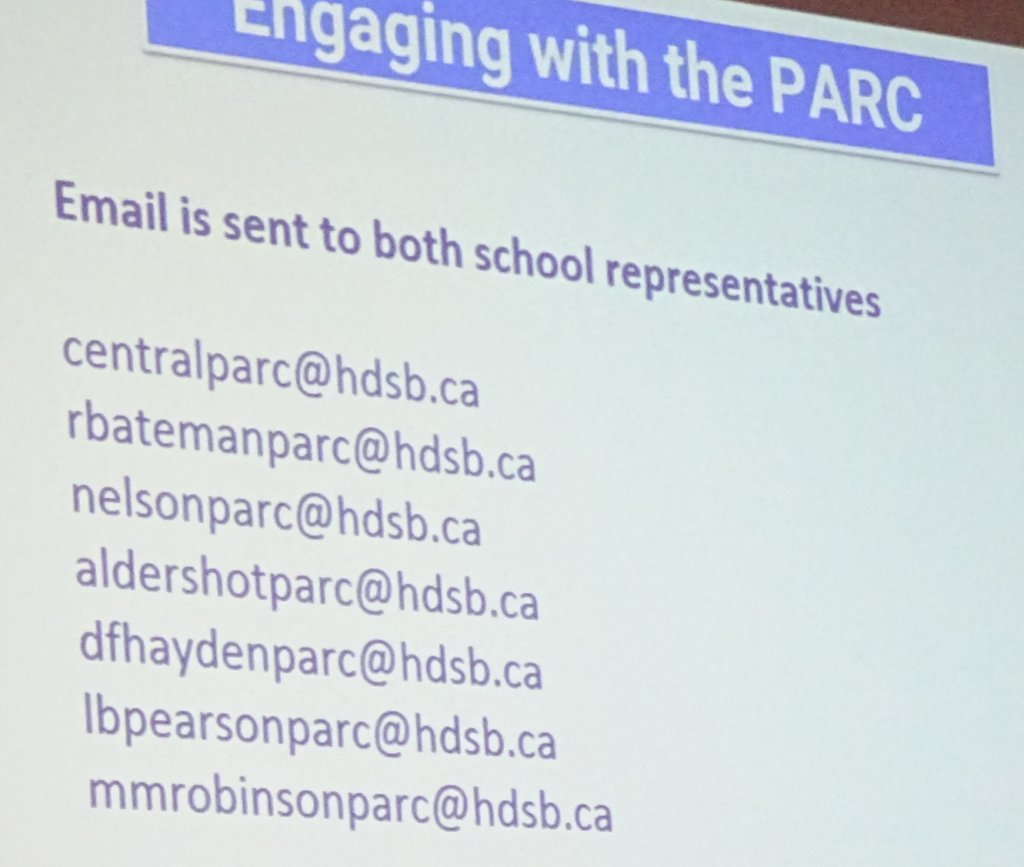 Those Program Accommodation Review Committee (PARC) members were expected to work with the parent groups and take the parent views back to the PARC. Those Program Accommodation Review Committee (PARC) members were expected to work with the parent groups and take the parent views back to the PARC.
The process had several layers of interaction that didn’t always go that well.
The Board staff wanted to control the meeting as much as they could. The facilitator brought in by the Board was expected to gather data and provide some analysis. That process did not go very well – the parents who took part in the several public meetings were not going to go quietly into the night and have a bunch of bureaucrats close their local high school.
Parents now had social media they could use to get their message out. The Gazette played a significant role in creating a platform parents could use to get their views out to a wider audience.
In any collection of people natural leaders emerge and the individual style of the participants comes to the surface.
The work load proved to be a little more than some of the original participants could handle and some of the participants had work commitments that conflicted with the PARC schedule requiring some changes in the PARC makeup.
The Central high school parents chose ward 2 Councillor Marianne Meed Ward to represent them. She was joined by Ian Farewell
Many felt that Meed Ward faced a conflict of interest – many more felt she not only had a right to be on the PARC but should be on the PARC because she was known as a pretty direct speaker and not the least bit shy about pushing the edge of the envelope.
Meed Ward was always pretty clear about what she stood for and always kept her election mantra right in front of her: “The people come first.”
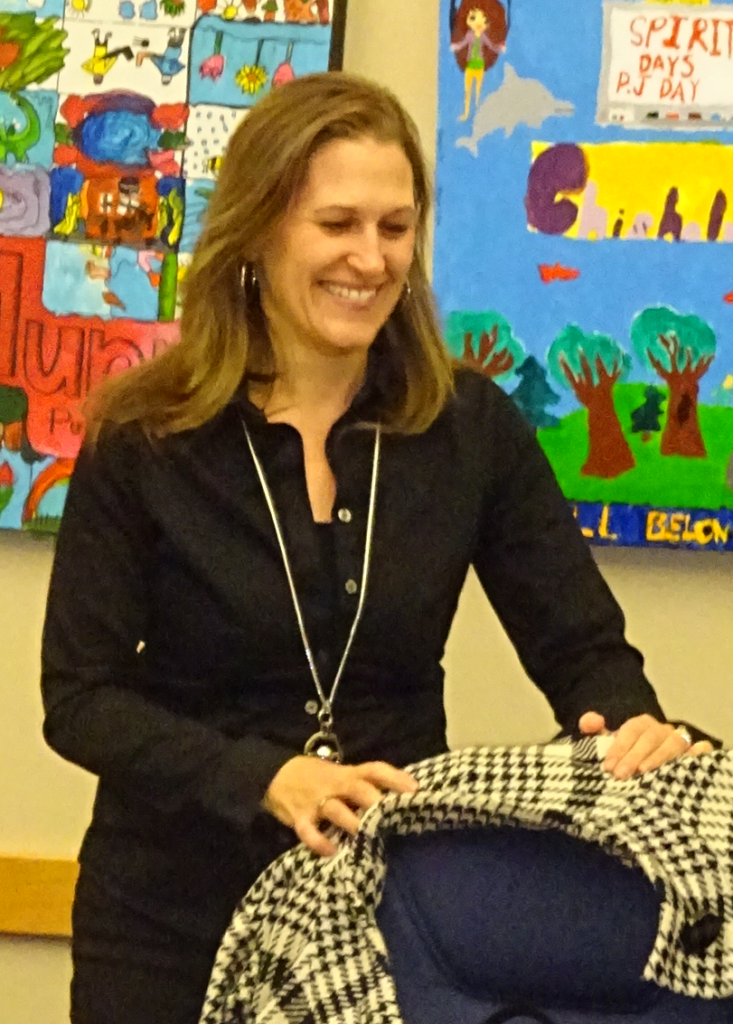 Marianne Meed Ward as a PARC participant The Meed Ward we saw at the PARC however, was not the same Meed Ward we see at city council. There is that memorable occasion when she forced her city council colleagues to stand up on four different occasions during a council meeting for a recorded vote – even through the outcome of the vote was a foregone conclusion.
Time and again she would return to an issue and ask questions. She asked more questions than any other two Councillors combined. She added furrows to the brow of the Mayor and may have changed the colour of some of the hair on his head as well.
We didn’t see that Meed Ward at the PARC meeting. She participated, rather well for the most part, but she was a much more subdued Meed Ward at a table some thought she should not be at.
She did at the last meeting let the Board know that she was not happy with the process she had to live with and wanted to be certain that the Board would interview all the participants and get their feedback on the way the process had worked out. She wanted both a group interview and if possible one on one face to face interviews.
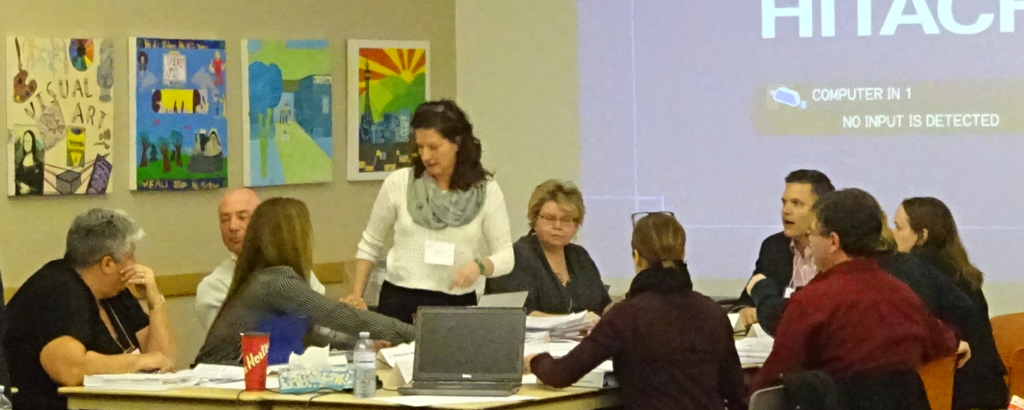 Cheryl deLugh standing centre, represented parents from Pearson high school. Pearson high school PARC member Cheryl de Lugt tuned out to be one of the stronger participants and came up with some of the best lines heard during the five meetings.
There wasn’t a single person who felt the PARC process was satisfactory. Director of Education Stuart Miller admitted that it had its shortcoming and those people at Queen’s Park that the Central parents spoke to when they met with the politicians and the bureaucrats admitted that the process could be improved.
The PARC rules and procedures were new and they did need some tightening up. The fear the Central parents have is that a poorly thought out process might result in their school being closed.
Few feel that Central should be closed – other than Board staff who focus on the cost of keeping Central open.
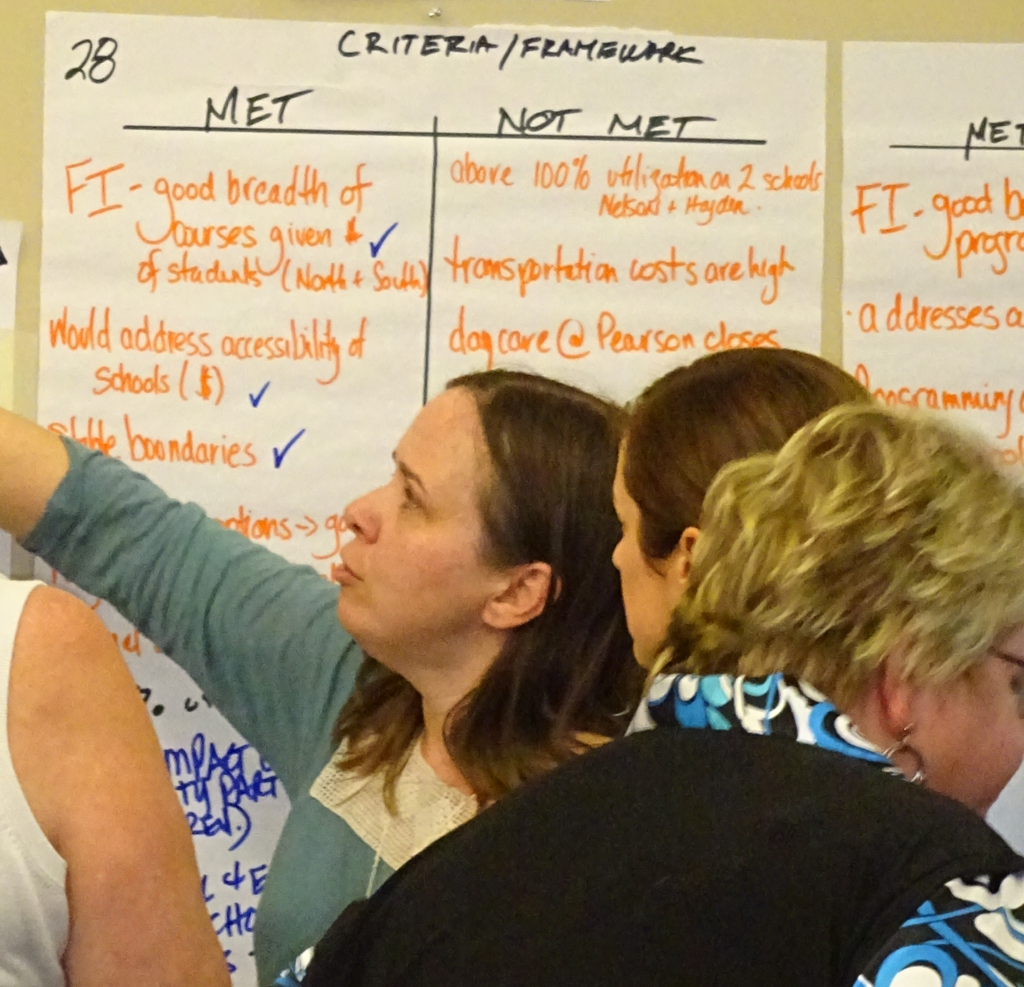 PARC members found themselves having to put the interests of their school ahead of the bigger picture – the interests of th city and its educational system. The PARC process put parents representing the different schools at odds with each other as they defended their school.
No one in the room was fighting for the city and the impact closing a high school in the downtown core would have.
Donna Danielli, the trustee advisor on the PARC said that the decision the trustees make is going to be one of the most important this Board makes.
She got that right – and it looks as if the process is going to prevent the best decision from being made.
Unless of course the 11 trustees choose to be brave and look at the bigger picture.

 By Pepper Parr By Pepper Parr
March 26th, 2017
BURLINGTON, ON
You would think that after three months of being tightly focused on the issue of closing two high schools in Burlington the 14 members of the PARC would be quite happy to call it a day and get back to living normal lives.
Hasn’t worked out quite that way.
During the past two meetings this PAR committee has found its footing and has become a group with two distinct parts; one that wants to go a little further and be more a part of the process that is going to make the decision rather than be just a group that was reacting and responding to questions put to it by the Chair Scott Podrebarac.
There are others that don’t want to do much more – they feel their school is safe and that the job is done.
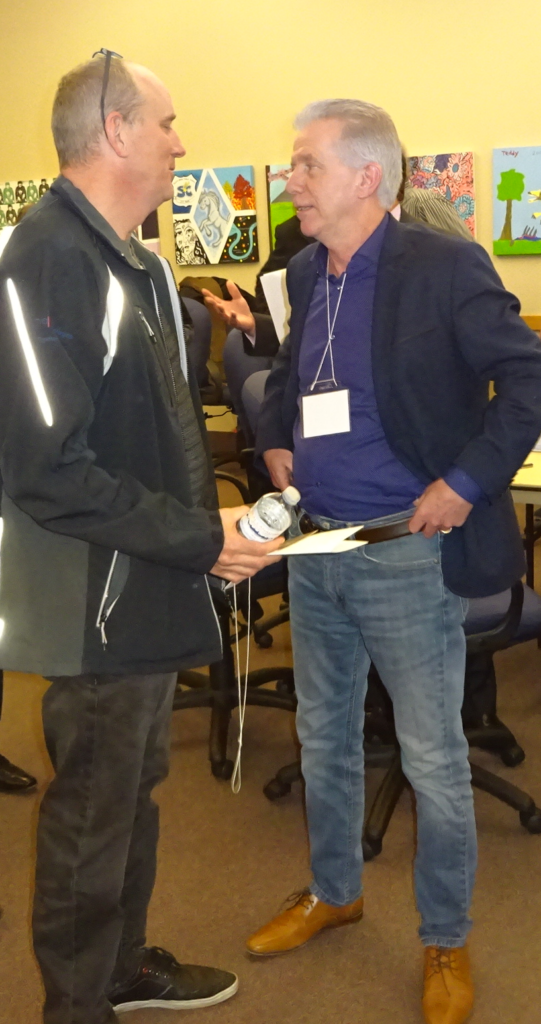 Ian Farewell, on the left, a Central parent and Steve Cussons and Aldershot parent were the two PARC members who never varied from wanting to keep all the schools open. Farewell was adamant that Central not be closed. Those who wanted to do more were able to prevail and there will be a sixth and final meeting Monday evening.
Steve Cussons, an Aldershot parent, wanted the PARC to be able to step beyond the 13 point framework they were given to work within and talk about some innovative ideas that could perhaps keep all the schools open. Cussons wasn’t able to define what he meant by “innovative” but it was clear he didn’t want to give up.
They were given a template to use as they made decisions on the various options that were put in front of them.
That template asked them to consider, but not be limited to the following:
1. Range of mandatory programs;
2. Range of optional programs;
3. Viability of Program – number of students required to offer and maintain program in an educationally sound and fiscally responsible way;
4. Physical and environmental state of existing schools;
5. Proximity to other schools (non-bus distances, natural boundaries, walking routes);
6. Accommodation of students in permanent school facilities and minimal use of portable classrooms;
7. Balance of overall enrollment in each school in the area to maximize student access to programs, resources, and extra-curricular opportunities and avoid over and underutilization of buildings;
8. Expansion and placement of new ministry or board programs;
9. Stable, long-term boundaries to avoid frequent boundary changes;
10. Cost effectiveness of transportation;
11. Fiscal responsibilities;
12. Existing and potential community uses and facility partnerships;
13. Goals and focus of the current multi-year
Starting with more than 40 options the PARC members whittled that down to the following five:
Option 23d ‐ Robert Bateman HS, Lester B Pearson HS closes, Dr. Frank J Hayden SS program change
No change to Aldershot HS boundary
Burlington Central HS catchment expands to include Tecumseh PS catchment
IB program added to Burlington Central HS from Robert Bateman
Nelson HS boundary expands east. SC‐SPED & Essential programming redirected to Nelson HS from Robert Bateman
MM Robinson HS ENG catchment expands to include Lester B Pearson HS
Frank J Hayden SS FI program redirected to M.M. Robinson HS. No change to the English catchment.
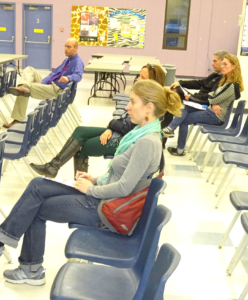 When the process of getting information out to parents few of them showed up at the Bateman high school meeting.
Option 4b – Robert Bateman HS closes
No change to Aldershot HS
Burlington Central HS expands to include the entire Tecumseh PS
Nelson HS expands east to include Robert Bateman HS. Nelson HS receives the SC‐SPED and Essential programming from Robert Bateman
MM Robinson HS catchment expands to include Kilbride PS catchment
Lester B Pearson HS catchment expands to include Florence Meares PS catchment. IB program and Gifted Secondary Placement added to Lester B. Pearson HS from Robert Bateman HS and Nelson HS
Frank J Hayden SS English catchment area is reduced.
Option 7b – Dr. Frank J Hayden SS Boundary change
No schools closed.
Lester B Pearson HS catchment expands to include Kilbride PS catchment area, John William Boich PS catchment area south of Upper Middle Road, and Alexander’s PS catchment
Frank J Hayden HS catchment reduced.
Option 28d – Burlington Central HS and Lester B Pearson HS closes, Program change for Dr Frank J Hayden SS
Aldershot HS catchment area expands easterly to railway tracks, ESL program added to Aldershot from Burlington Central
Nelson HS catchment area expands west to the railway
Robert Bateman HS catchment area expands to include John William Boich PS catchment area and Frontenac PS catchment
MM Robinson HS catchment area expands to include Lester B Pearson HS catchment area.
FI is removed from Dr. Frank J Hayden SS and redirected to MM Robinson HS
CH Norton PS area that is currently directed to Lester B Pearson HS, to be redirected to Dr Frank J Hayden
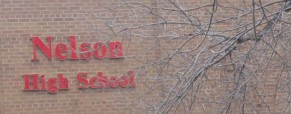
Option 3b – Nelson HS closes: Dr Frank J Hayden SS and Burlington Central HS have a program change
Aldershot FI expands to include Burlington Central HS FI catchment
Burlington Central HS English catchment area expands to Walkers Line
Robert Bateman HS expands west to Walkers
FI program added to Robert Bateman HS
Lester B Pearson HS catchment area expands to include John William Boich PS catchment area and Kilbride PS catchment area. The Secondary Gifted placement added to Lester B Pearson HS from Nelson
Frank J Hayden SS FI program redirected to M.M. Robinson HS.
Frank J Hayden HS catchment reduced.
Earlier in the proceedings it looked as if the Board recommendation of closing two high schools – Central and Pearson was a go. The option to not close any schools had some traction during the first round of cuts but the Board staff original recommendation was at the top of the list.
The focus when the first cut was done shifted to hard lobbying by the Bateman and Nelson parents to ensure that they were not closed.
Nelson appears to be safe, but Bateman is still very much at risk.
When this process started Director of Education Stuart Miller said many times that the option that board staff put forward and the trustees agreed to might not be what the PARC committee would agree on and it might not be what the trustees decided on.
Staff had many choices – they felt that closing Central and Pearson was the best of the more than 40 options that were considered.
The sense at this point is that Pearson needs to be kept open to handle the overflow that is going to be seen in the northern part of the city. Pearson was a purpose built school – it is the smallest of the seven high schools and has more property than any other high school in the city. Hayden is already at close to 150% of it rated capacity.
Option 7 – a decision not to close any of the high schools had a bit of a battle to remain on the list. Some PARC members thought such an option voided the whole purpose of the PAR process while others felt very strongly that the public had the right to voice an opinion on whether or not they wanted any of their high schools closed.
Cussons and a number of other PARC members want to keep all the schools open – and they think there are some innovative approaches that can result in just that.
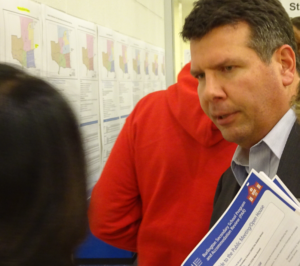 PARC chair Scott Podrebarac. Chair Scott Podrebarac is bending over backwards to give the PARC people every opportunity possible to talk through every idea they have. He has gone so far as to revise the schedule that moves everything back by almost a month with a final decision to be made on June 17th. That decision was supposed to be made on May 19th.
The critical dates going forward are:
Friday April 21, 2017 – Director’s Final Report released online at www.hdsb.ca
Wednesday April 26, 2017 (6 pm) – Director’s Final Report will be presented to the Board of Trustees at the Committee of the Whole meeting.
Monday May 8, 2017 (6 pm) – Public Delegation Night.
Thursday May 11 (6 pm) – Public Delegation Night. These evenings will be live-streamed on the Board website. Location: J.W. Singleton Centre (2050 Guelph Line).
Wednesday May 17, 2017 (7 pm) – Board meeting. Final Report to Board of Trustees for “information”.
Wednesday June 7, 2017 (7 pm) – Board meeting. Final Report to Board of Trustees for “decision”.
Is the PARC going to be able to come up with some ideas that will make it possible to keep all the schools open? Will all the PARC members show up for this final PARC meeting?
The process the city is in created the PARC as the link that would take all the options the Board came up with and communicate them to the parents. The PARC has no authority – all it does it pass along its ideas.
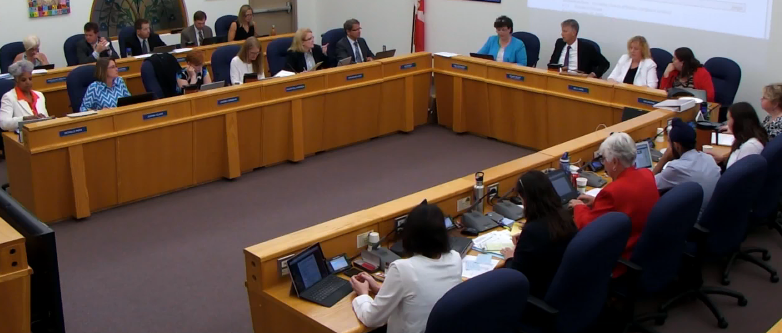 The Halton District School Board trustees The trustees are the people who will make the final decision. They don’t have to accept the recommendation the Director of Education makes. They do have to reflect the will of the people.
And, it is not just the four Burlington trustees who make that final decision; all 11 trustees have a vote. The dynamics of how that vote turns out is going to make the 2018 elections very interesting.

 By Staff By Staff
March 24th, 2017
BURLINGTON, ON
It isn’t over yet friends.
The 14 members of the Program Accommodation Review Committee (PARC) decided last night that they wanted on more kick at the can – and while the Chair, HDSB superintendent Scott Podrebarac wasn’t excited about the idea – it became evident that there were enough people who wanted to meet again to talk about innovation and how the Board of Education might look at different options when it comes to closing schools.
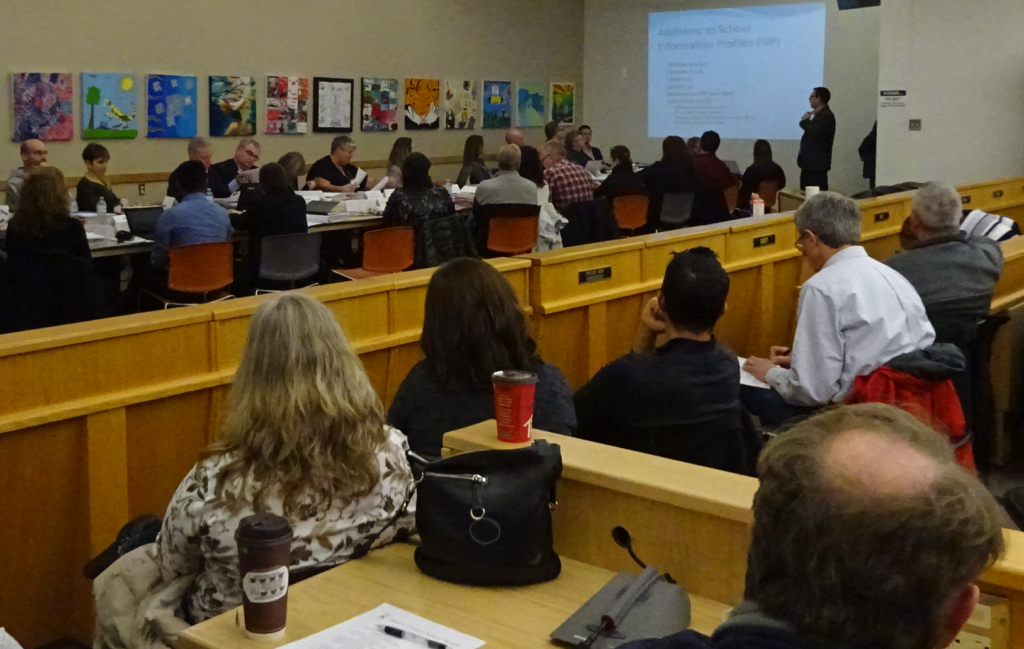 The PAR members deliberating with the public watching and listening. As well, it had become clear that the original time table could not be met. So everything got bumped back by about as much as a month.
Monday, April 17, 2017 is the first date to submit online Delegation Request Form for the May 8 Delegation Night.
April 20, 2017 – First date to submit online Delegation Request Form for the May 11 Delegation Night.
April 21: Director’s Final Report will now be posted on April 21
April 26th: Committee of the Whole will meet on April 26 at 6:00 pm to discuss the Director’s Final Report that will have been distributed to the Board of Trustees. The Committee of the Whole meeting will take place at the J.W. Singleton Centre (2050 Guelph Line, Burlington). This meeting will be live-streamed on the Board website. If additional audience capacity is required, it will be available at M.M. Robinson High School (2425 Upper Middle Road, Studio Theatre).
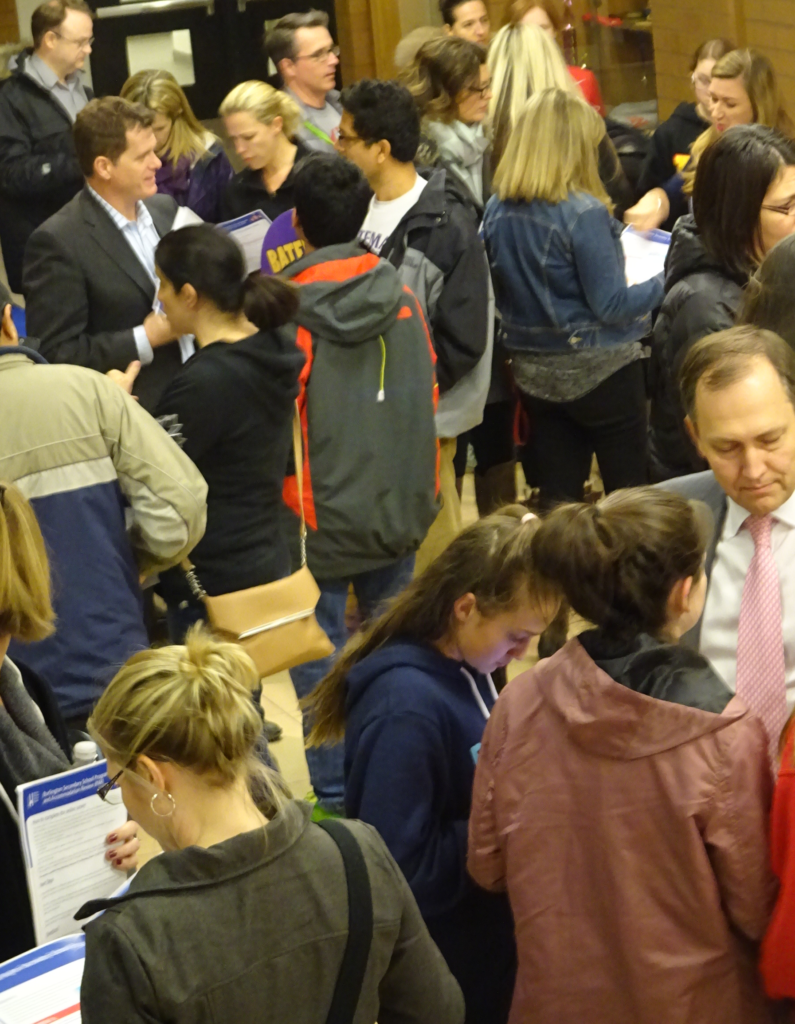 It was standing room only at the information meeting in March. May 8 delegation night
May 11 delegation night
Delegation Nights will be May 8th and May 11th. There will be 25 delegations heard each evening. A delegation lasts five minutes. Traditionally delegations are recognized on a first come first served basis. Cheryl deLugt, a PARC member representing Pearson high school, asked if that policy would apply to the PAR matter and was told that there would be a different arrangement for this matter.
Monday May 8, 2017 (6 pm) – Public Delegation Night. These evenings will be live-streamed on the Board website. The meeting will take place at the J.W. Singleton Centre. Seating priority in the Boardroom will be given to delegates. If additional audience capacity is required, it will be available at M.M. Robinson High School (2425 Upper Middle Road, Studio Theatre).
May 11 (6 pm) – Public Delegation Night. These evenings will be live-streamed on the Board website.
Location: J.W. Singleton Centre (2050 Guelph Line). Seating priority in the Boardroom will be given to delegates. If additional audience capacity is required, it will be available at M.M. Robinson High School (2425 Upper Middle Road, Studio Theatre).
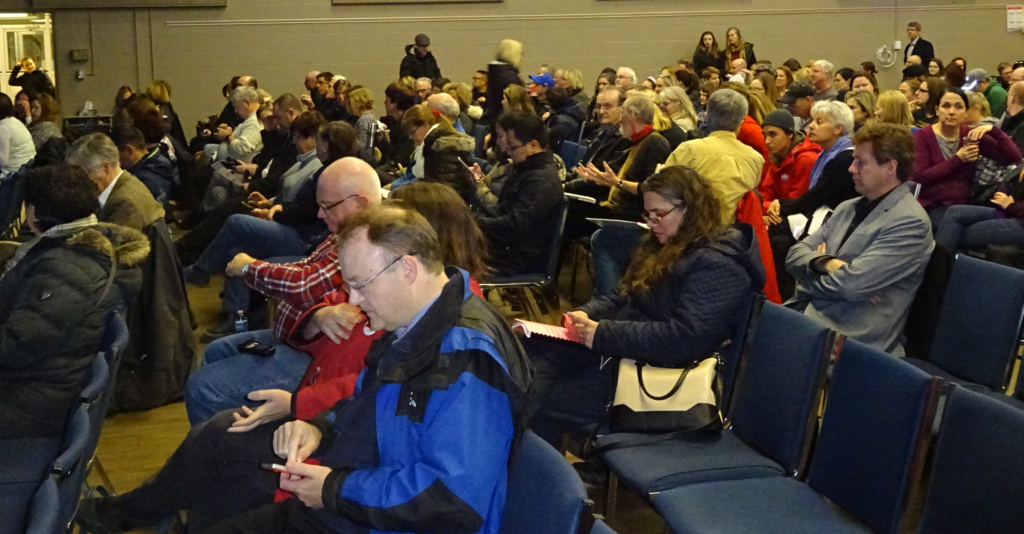 An early December meeting had some empty seats. May 17: Director’s Final Report Report goes Board of Trustees for “information”. Location: J.W. Singleton Centre (2050 Guelph Line). If additional audience capacity is required, it will be available at M.M. Robinson High School (2425 Upper Middle Road, Studio Theatre).
June 7: Final Vote by the trustees will be made on June 7. Final Report to Board of Trustees for “decision”. Location: J.W. Singleton Centre (2050 Guelph Line). If additional audience capacity is required, it will be available at M.M. Robinson High School (2425 Upper Middle Road, Studio Theatre).

 By Pepper Parr By Pepper Parr
March 24th, 2017
BURLINGTON, ON
During the Program Accommodation Review (PAR) deliberations taking place at the Public School Board, and in the comments made by people in the Gazette, mention is often made of how the 1800 empty seat problem could be solved if the Catholics just moved into the public schools.
Words like that reflect a serious misunderstanding of the country’s culture and constitutional history. The existence of the Catholic schools is far more than culture and constitutionality. We asked former Halton Catholic District School Board chair Jane Michael to explain the reason we have Catholic schools. Here is what she had to say:
When my kids were growing up, I made it clear that to get anywhere in life, you had to set clear goals, have a very strong work ethic and you had to be honest. A very high value was placed on education. Coming from parents of immigrants, on both sides of my family, that value was instilled very early in life. In short, there were high expectations to work hard, learn and succeed.
We chose to send our children to Catholic school.
I have seen it written on many a wall –
Christ is the reason for this school. He is the unseen but ever present teacher in its classrooms. He is the model of its facility and the inspiration of its students.
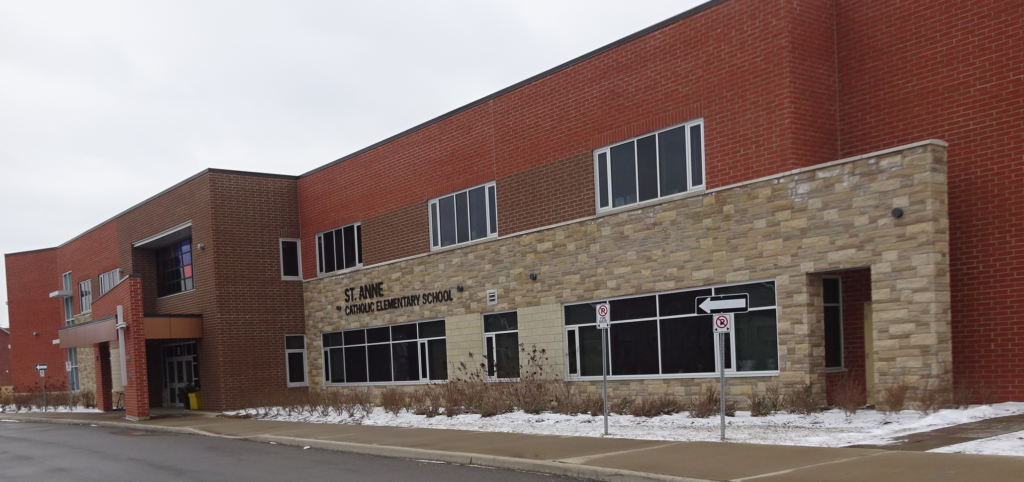 St Anne Catholic elementary school in the Alton Village In the Catholic schools, in addition to the teaching of the Ontario Curriculum, a routine of praying is included, a respect for God and for the Church as well as for oneself. The students embody multiculturalism. The educators are united in teaching from a moral compass.
There has been a growing discussion around a one school system. Still, all three political parties are on record as supporting the Catholic school system as an integral part of publicly funded education in Ontario. In particular, the discussion revolves around a one board system. This ignores the fact that Ontario has four overlapping school boards.
Catholic education is part of Ontario, rooted in history. In 1867, the British North America Act guaranteed the educational rights held by minorities at Confederation. I firmly believe that the solemn promise made at the time of Confederation should be kept. It is hard to ignore the wishes of 650,000 children. Ontario is offering publicly funded French schools, Art schools, gifted schools, plus AP/IB schools.
Catholics have paid for their own system and despite changes in funding, still do so today. Catholics are more than one-third of the province’s population, and if I add up Catholic school board supporters, I may say that we are self-funded, as opposed to publicly-funded. Catholic schools have maintained their place in Ontario’s public education system for almost 170 years. It is the Constitutional mandate of Catholic schools to provide Catholic education to Catholic students.
The Catholic school boards have the preferential right to hire Catholic teachers, committed to the goals of the Catholic school system This right is extended to publicly funded social welfare agencies. Catholic high schools admit non-Catholic students, providing open access. Catholic education has grown to include a supporting strong infrastructure of Catholic organizations. Ontario’s French language school system is also divided into public and Catholic. The French Catholic system is supported by French Catholic parents and ratepayers. Ontario Catholic school boards consistently meet or exceed provincial expectations.
My kids’ Catholic elementary and secondary schools were and are, deeply invested communities. Our community, one of warmth and faith, prepares the mind and the soul for the future. Teaching combined academic lessons with those on morals, and good behaviour, and is consistent with religious instruction throughout the whole year. For my family, that was the best of both worlds. Everyone goes through difficult times in life, and going to Catholic school and having faith is very important in order to survive these times.
Catholic education focuses on the entire child; their mental, physical and spiritual selves, as well as core values we have attempted to instill at home. Education is, and always be, a priority in my home, and the school reinforced the need to study and be decent human beings.
Having God in the school makes these kids grow into pretty great people. And, it’s not about being indoctrinated into any one religion. Catholic schools teach the kids to respect others and their religions as well. Catholic Boards mandate that students in Grade 11 study World Religion. When our kids came home from school, they told us of their experiences with the Church and school. I think it helps with behaviour once they know what God expects of them. They want to please God as well as others and they want their parents to be happy and proud of them. Understanding other groups and others’ beliefs is an important part of Catholic education’s teachings; respecting and affirming the diversity of today’s world.
Immersion in Catholic school culture, where religious themes are woven throughout classes and extracurricular activities each day made God a consistent presence and force in the lives of my kids and their classmates. I will always choose Catholic schools. Education is an intensely personal family choice. Historically, the education of our children was always conducted by family. That remains today. Kids spend the majority of their day in school. I will always look for what is in my family’s best interest.
Speaking to a high school graduation class, a graduate came up to me afterwards and said: “I didn’t really get it – why going to a Catholic school mattered so much. Now that I am about to leave, I know that God will always be with me, that He’ll always keep me safe, and He’ll help me whatever life has in mind for me. I’m not afraid anymore”.
It doesn’t get better than that.
 Jane Michael is a former Chair of the Halton Catholic District School Board. Jane Michael is a former Chair of the Halton Catholic District School Board.

 By Pepper Parr By Pepper Parr
March 23, 2017
BURLINGTON, ON
Spending as much as five minutes on what is normally the snooze of the season is not high on the things to do this week list for most people.
But the situation has changed and some people might actually want to spend some time on letting the Board of Education know what they think of the amount of money gets spent on education.
Parents and community members says the Board media release are encouraged to provide input on the 2017-2018 budget priorities. Input may be submitted online until Monday, April 17, 2017
They go on to say: The Halton District School Board values input from parents/guardians, members of the public, staff and students concerning the development of the 2017-2018 budget.
Individuals are encouraged to provide their input concerning the budget priorities for the upcoming school year online through the Halton District School Board website at www.hdsb.ca. Follow the link from the homepage or directly here. Input must be received by Monday, April 17, 2017.
Here is the direct link to the budget input page – get ready for a shock. What you see below is it – one place to write some comments – click finish and you are done. Part of the name in the url is “checkbox” They seem to feel that they have asked for input – and having done that they can check off that box.
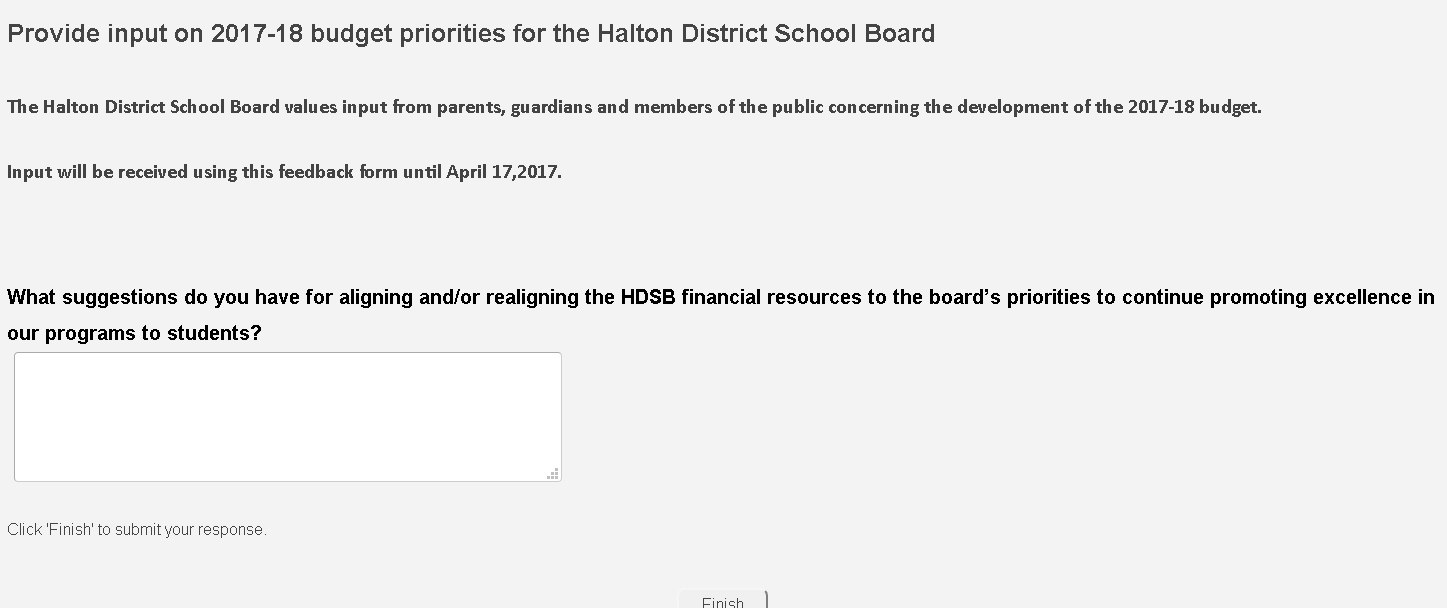 This is the input page – nothing more. They do suggest in the media release that people might want to bone up on what the current policies are but they don’t provide easy to use direct links. The Board of Education web site is nothing to marvel at. Before providing input, individuals are encouraged to review the Board’s Multi-Year Plan, Special Education Plan and Operational Plan. A key objective of the annual budget process is to align the Halton District School Board’s financial resources with these important documents. Information and updates regarding budget development are presented to Trustees at Committee of the Whole meetings.

 By Pepper Parr By Pepper Parr
March 22, 2017
BURLINGTON, ON
Quantitative? Qualitative?
How many people responded to the survey and was there balance in the responses.
Tuesday evening the PAR Committee members were given a briefing on what the 1611 people who completed the on-line survey had to say about the six options to close high schools that were on the table.
The details on that survey were published as a separate article.
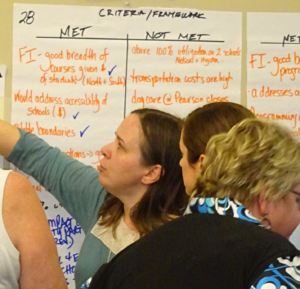 PARC members writing their comments on large sheets of paper. This PARC has had difficulty with getting good data and pulling information from that data that can be used to determine the best direction.
The process the province put in place to involve parents is now seen as deficient. It is new and will no doubt be changed but the PAR committee has to work with what they have been given.
The chair of the PARC appears to b ready to loosen things up a little. Scott Podrebarac, a Superintendent with the Board, is running meetings under a process that is new – he is sort of learning what to do each meeting. Many of the PAR committee members want a more open process.
Last night the public heard the numbers part of the quantitative part of the data. There was a lot of discussion about the value of the data. The number of responders was small and it was a complex survey with the average time spent by those who completed it amounting to 21 minutes. The Board did no report on the number of people who did not complete the survey.
The qualitative aspect wasn’t discussed on Tuesday. There were tens of thousands in the way of comments. How do they get tens of thousands of comments from 1600 + responses? There could have been as many as seven comments from each person (7 x 1611 = 11,277) and the PAR committee wanted to see every one of them.
 PARC members from Aldershot and Central high schools. There is a significant level of distrust between the Board staff and some members of the PARC. They are complaining about the quality of much of the information they are being given and unhappy with the Terms of Reference they have been asked to work within.
Some members of the PARC feel the Board staff will present just those comments that support their option – which was to close two of the seven high schools.
Board staff talked about privacy issues in releasing all the comments. Blank out anything that identifies anyone responded those PARC members who are unhappy with the way Board staff have been managing the flow of information.
It has taken the 14 PARC members time to begin to work as a group – almost from the beginning the PARC members spent their time and energy defending their schools. When it became evident that both Nelson and Bateman were being considered for closure their representatives became very vocal.
The committee began to feel that the Board staff had them working against each other to save their school when what many of them wanted to do was find a solution that could keep all the schools open
The parents wanted to be part of a process that was going to look for a solution and they felt they weren’t being allowed to do that.
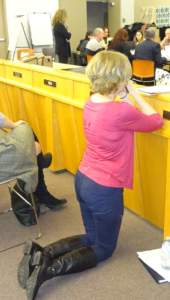 Lynn Crosby didn’t want to miss a word that was said. It was difficult at times to hear what the PARC members were saying There might have been a bit of a change in the way the Board is managing this process. The trustees are meeting this evening – Wednesday and are expected to add additional meeting time for the PARC members to deliberate.
There is quite a bit more to take place – the real leaders should become more evident very soon.
And everyone is waiting to see what those tens of thousands of comments actually say.

 By Pepper Parr By Pepper Parr
March 22, 2017
BURLINGTON, ON
The gloves are coming off!
While the Board of Education is considering adding more time for the PAR committee to continue their deliberations there are people who have been working on this file for more than eight weeks who are beginning to get very fed up.
“My personal view” writes an advisor to the Central Strong parents group is “ at this time is to STOP this nonsense immediately. It has become nothing more than another episode of The Twilight Zone.
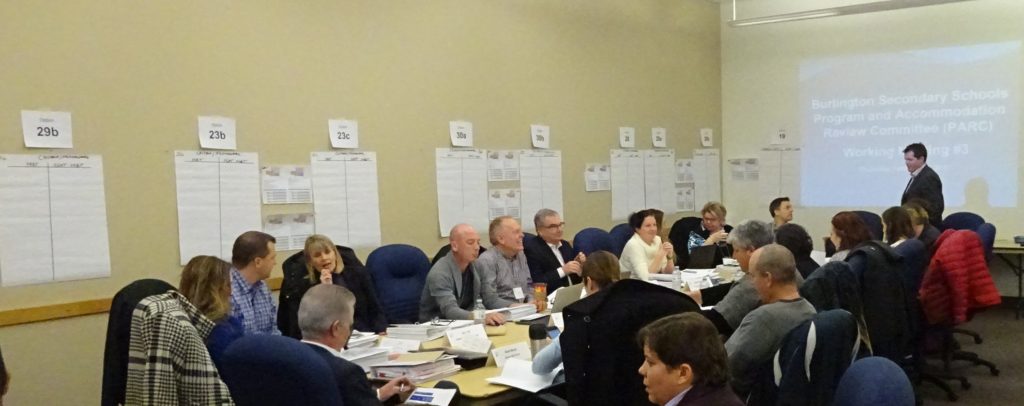 The PAR committee members with the advisors. “You, and other ALL other parents and concerned individuals from ANY High School who are VOLUNTEERING their time and resources, are in an unfair fight against people who are getting PAID by you to fight against you and to make you fight against your colleagues and parents from other communities. All the while restricting access to information that they control.
“I strongly suggest that a meeting be called’ inviting ALL parents, concerned individuals, and the media but NOT Board people or Trustees, to consider STOPPING this process ASAP.
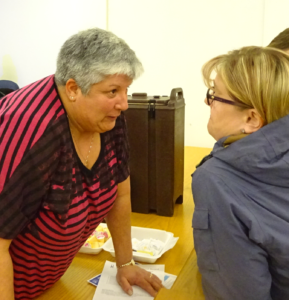 Bateman high school representative on the PARC exchanging views with a parent. “Do not issue a Report and refuse to participate in the BS any longer. Boycott this whole mess and send a petition, signed by everyone, to the Premier and Minister of Education, saying that ‘enough is enough’.
“No Report, No Decision, No Schools closed. All of the Parents and Students win until a FAIR, OPEN and TRANSPARENT process is established by the Ministry of Education. “
The advisor has asked that he not be identified at this point, has been helping the Central parents get data and plan a strategy.
If there is a meeting held the Gazette will cover it.
The line that “No Report, No Decision, No Schools closed” is not accurate. The PARC members are not asked to write a report. The Chair of the ARC a school board Superintendent will write the report from the PARC to the Director.
The PARC members could all walk out tomorrow – won’t make a difference – the Chair will still write a report and mention (maybe in a footnote) that the PARC members chose not to continue.
Hold the meeting and be as public as you can. Then have several of the PAR Committee members write a report of their own and submit it to the Director of Education and demand that he include it in his report to the trustees.
Don’t expect all the PARC members to be part of this approach but if there are enough of them – a majority would b nice – it will have an impact.
This is getting a little feisty isn’t it?

 By Pepper Parr By Pepper Parr
March 22, 2017
BURLINGTON, ON
It was a very productive meeting and the Program Accommodation Review heard comments that several thought they would never make – the committee had found its voice – and for the first time ever there was a round of applause from the people – 30 some odd – in the gallery.
The meeting – the fifth to date, started with an overview of the data that was collected through an on-line survey that everyone agreed was not accurate and had no validity in terms of useful information. Nevertheless it did reveal something.
The members of the PARC are not at all excited about closing any of the schools – and they want to take a time out and pause to get a clearer sense of where they are going.
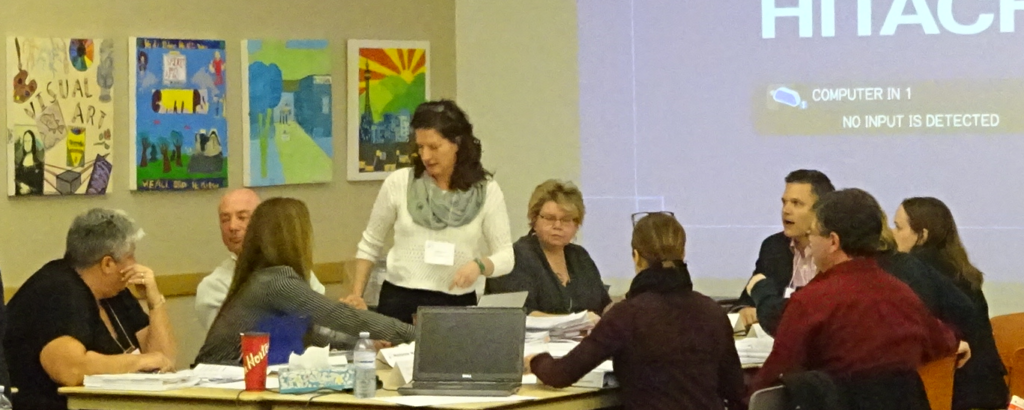 Cheryl deLugt, a nurse, told the PARC members that she felt they all needed to take a “time out” and determine just what it is they are supposed to be doing. Many other members of the PARC felt the same way. Lester B, Pearson parent Cheryl deLugt, who works as a nurse, told her fellow PARC members that she felt the committee needed a time out and explained a procedure that operating room staff use:
1-is this the right patient, 2-the correct surgery and 3- is it the right procedure.
Many felt that the PARC had not really found its way and didn’t like how the process had gone so far. They want to review what they have done so far and determine how much flexibility they have on what they can put forward.
DeLugt wanted the board to call a time out – pause and look at what has been done and what hasn’t been done and what they might do better. To follow the deLugt dictum they have the right patient; no one is sure they are doing the right thing and few are certain they are doing it the right way.
The Board of Education will meet Wednesday evening and the expectation is that they will revise the schedule that is supposed to have the Director of Education delivering his report to the trustees.
The sense is that more time is needed – quite a bit more, for the PARC people to offer some innovative ideas which they weren’t at all sure they could do.
1611 people responded to the survey. The details on the survey results are covered in a separate story.

 By Pepper Parr By Pepper Parr
March 22, 2017
BURLINGTON, ON
Capturing data that is valid, balanced and detailed enough to tell research analysts what people think and what they would like to see done has been a challenge for the Program Accommodation Review Committee (PAR).
The Halton District School Board hired IPSOS Reid to take on the data gathering and the analysis of the data that was gathered as well as create the questions that would give both the Board, the trustees and the members of the PAR the information thy needed.
If you want to count how many chickens there are in a coop – there have to be some chickens – which is an awkward way of saying that IPSOS Reid was never able to get balanced data.
The first survey they did of parents at a December meeting was so skewered to Central high school parents that it was difficult to project what parents from all seven high schools thought about an issue.
The second survey that ended March 13th does not appear to have been all that much better.
IPSOS Reid presented an Overview of the data gathered on what responders thought of the six options for possible school closing were still on the table. The names given to some of the options were not as clear as they needed to be – for example 7b was to not close any of the high schools and change the Hayden boundaries.
 Most of the options that came forward went through some modifications which added an alpha to the number. Thus 7b had at least two changes made to the original content. Most of the options that came forward went through some modifications which added an alpha to the number. Thus 7b had at least two changes made to the original content.
The next piece of data explained who was answering the survey – a parent, a student – who?
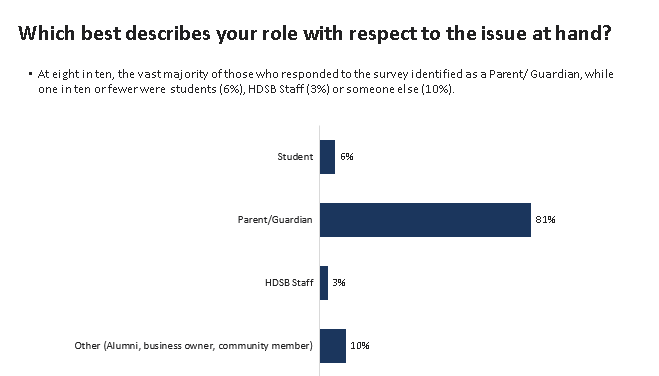 The PARC wanted to know who was responding – – the vast majority were parents. The PARC wanted to know who was responding – – the vast majority were parents.
Which school did the responder represent as the next concern. What surprised many was that more of the responders came from Nelson high school which while on the list of possible closures was not nearly as at risk as Central, Pearson and Bateman.
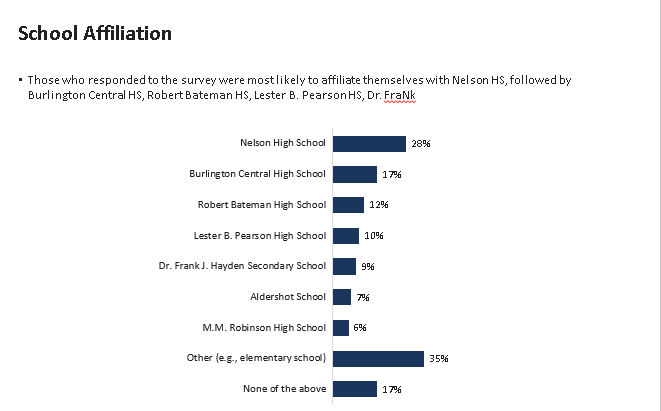 Knowing who was responding to the survey, which schools they represented the researched asked the responder what they thought the impact would be for each option from their perspective. Knowing who was responding to the survey, which schools they represented the researched asked the responder what they thought the impact would be for each option from their perspective.
The data for all six options was formatted the same way.
We have set these out for each of the six options.
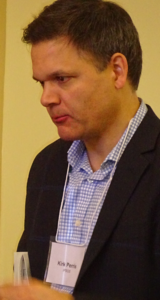 Kirk Perris, IPSOS Reid researcher who presented the data on the second survey. There were 1611 responses to the survey.
People completing the survey had seven choices from most positive to least positive. The blue area indicated people saw this as having a positive impact. grey was neutral, orange indicated a negative impact.
Kirk Perris, the IPSOS Reid researcher did point out that there was no certainty that the responses were all valid by which he meant that he could not say for certain that one person did not complete the survey many times,
He did point out that the average person who did the survey spent 22 minutes doing so which suggested that the bulk of the responses were valid. This wasn’t a survey you could race through.
Perris said the most important part of the survey was the comments people made – that data will be presented to the PARC at their next meeting on Thursday.
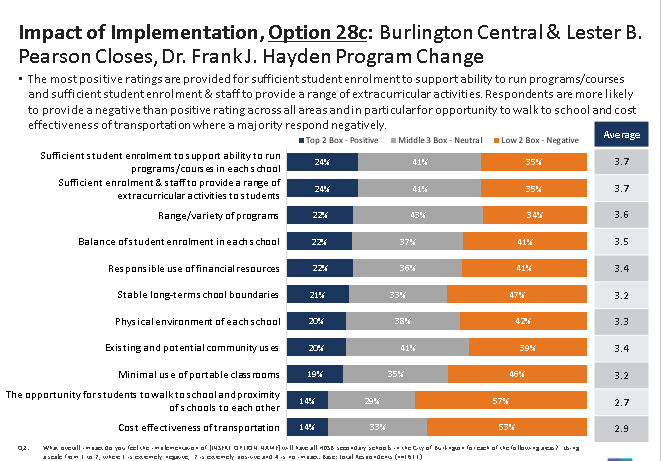 This option is slightly different than the option Board staff originally put forward. It has more to do with boundary changes than the closing of a specific school. 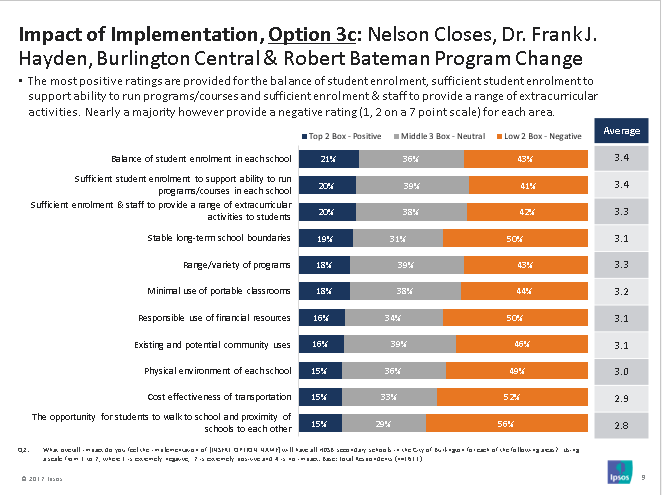 Once this option – closing Nelson was on the table the parents from that high school suddenly got very active. More Nelson parents responded to the survey than any other school – there involvement is reflected in the data. 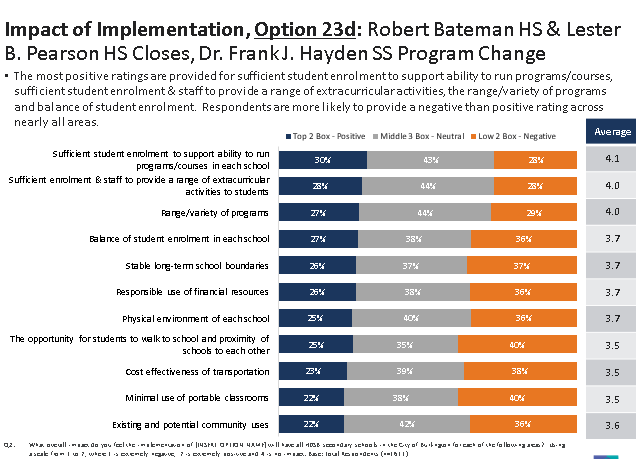 Closing Bateman and Pearson would solve the 1800 empty seats – Parents at Pearson felt that if they were given the students that were taken from them and sent to Hayden they would be viable. 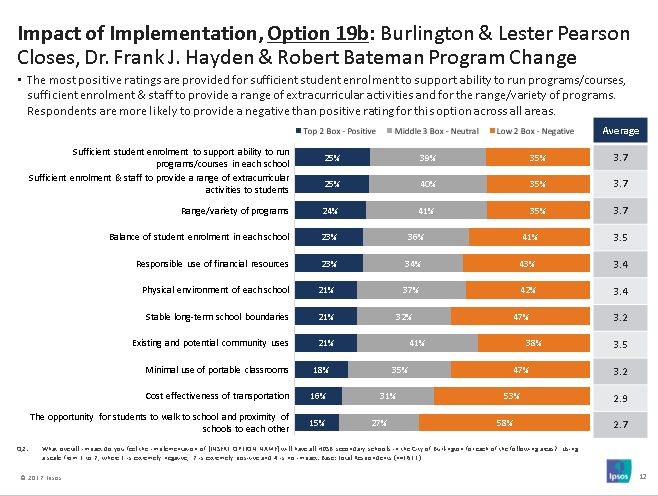 This option was the one the Board staff put forward. It had much higher negative responses than the option that appeared to be the most favoured which was #7 – don’t close any of the schools. 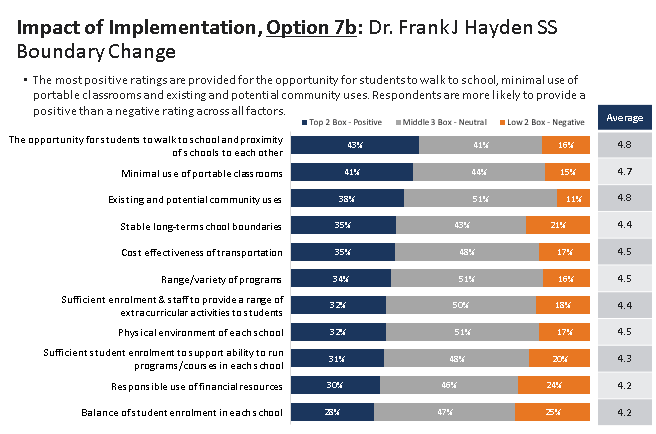 This option to not close any of the schools had the most or highest favourable response – but it doesn’t resolve the problem of those 1800 seats that are empty. 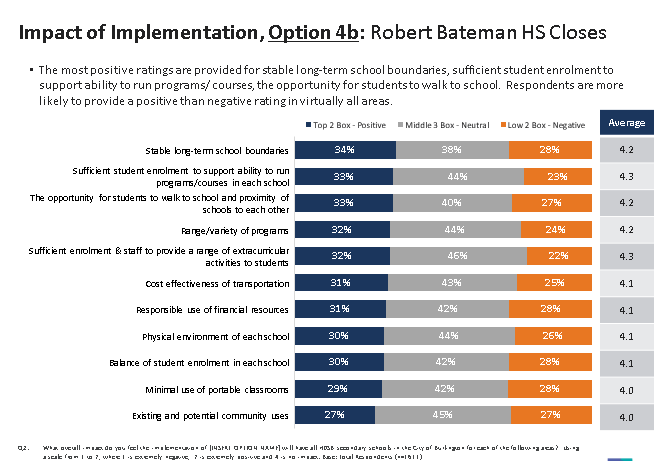 Closing just Bateman was not a clear choice – the positives outweighed the negatives but people felt neutral about many of the questions.

 By Staff By Staff
March 20th, 2017
BURLINGTON, ON
IPSOS Reid will not complete the analysis and formatting of the data on parent views related to the possible closing of two high schools in the southern part of the city. The data was collected during the first half of March.
They will deliver the data to the Halton District School Board on Wednesday in advance of the last PARC meeting on Thursday.
On Tuesday they will give a top line overview and discuss some of the major results from the survey.
There were 1611 responses to the survey which was apparently sent to every parent or guardian the school board had an email address for – seems like a very low response for such a contentious issue.

 By Pepper Parr By Pepper Parr
March 20th, 2017
BURLINGTON, ON
If your household is anything like mine the Netflix subscription is key to whatever time there is for home entertainment or the occasional binge on a series you just learned about.
Lie to Me keeps me away from the writing – I tend to take in three or four episodes at a time
So when an email showed up saying there was a glitch in renewing the subscription I pay close attention, I didn’t want to be cut off.
I use a prepaid credit card for everything I buy online; that allows me to limit any loss that might occur should someone manage to actually get their mitts on the way I pay for things.
I thought maybe I had forgotten to top up the amount on the card.
If you don’t know what a prepaid credit card is – talk to your bank manager. A safe proof way to protect your real credit and at the same time limit any loss.
I have taught myself to look at the url on every piece of email that comes in related to money.
The url is the the name of the address the email came from. In his instance it read: (EXPLAIN)
Take a look at the url on this example: Netflix <noreply@netflix.ssl1.com> Anyone could have made up that email address. You could go on line now and create an email address that reads @netflix.ssl2.com
 This notice was not from Netflix; it was from someone who wanted me to click on that blue line which would direct me to a website where they could begin milking me for personal identity information. Don’t get pulled into things like this – look at the url
This is a legitimate Netflix email url: Netflix <info@mailer.netflix.com>
This was a scam – you can teach yourself the same little tricks and keep your bank happy at the same time.
Few people have any idea how much time the banks have to spend handling the return o funds that were taken illegally from an account. That plus the money that have to pay out.
The cardinal rule is this: If in doubt – don’t. And if it looks to good to be true – it usually isn’t true. Trust your instincts and reign in the greed all of us have.

 By Pepper Parr By Pepper Parr
March 20th, 2017
BURLINGTON, ON
The leading news story this past few months has been the work being done by the Halton District School Board to close two of Burlington’s seven high schools and the work being done by parent groups to keep their local high school open.
It is no surprise that the two are at odds much of the time.
Part of the process required to close a school is a Program Accommodation Review (PAR) that crates a committee of people, two from each high school, who are tasked with being the official conduit for information shared between the Board of Trustees and school communities.
They were given a framework to guide their deliberations. They had no input on what those guidelines were.
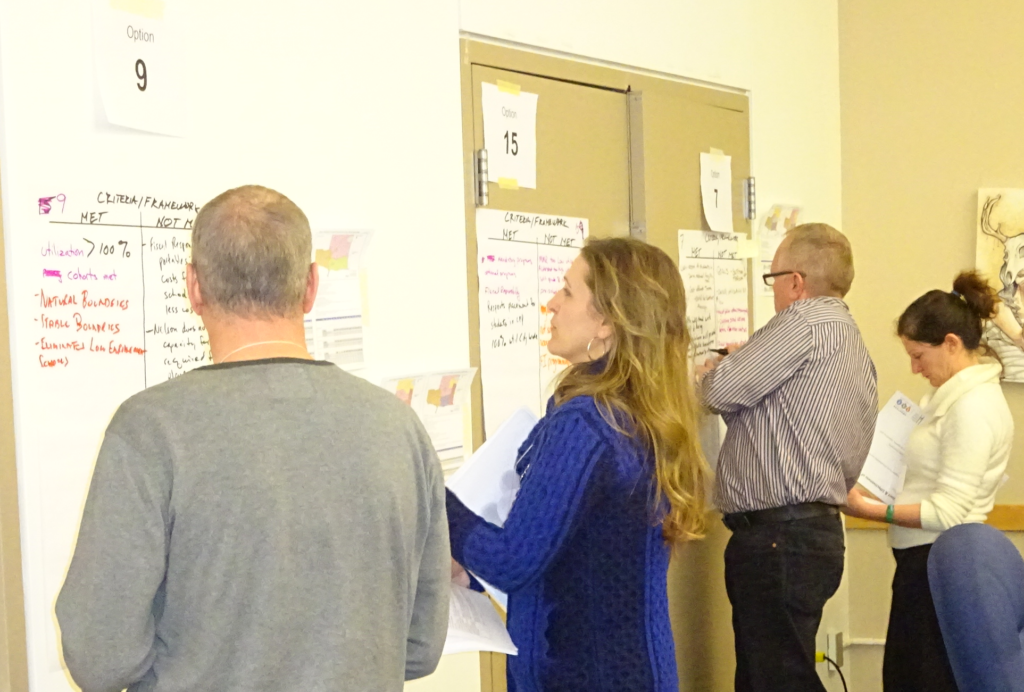 PARC members putting their choices and comments on large sheets of paper. This was part of the process of whittling down the 30 options that came forward down to the six that are now before the committee. The fourteen people chosen to do this work, which is proving to be close to exhausting, have a tough job to do – and the HDSB doesn’t make it any easier.
The biggest issue appears to be the data that is collected and the information the Board staff pass along.
 Parents at a December 2016b meeting entering their choices on hand held devices as they responded to the 25 questions that were asked of the audience. The data had little relevance because it lacked any balance – more than 50% of the respondents were from the one school. Two surveys have been done, the first on December 8th at the New Street Educational centre where those in attendance got to use clickers to indicate their choice on 25 different questions.
The problem with the data that came out of that questionnaire was that more than 50% of the people responding were from central high school. The data was severely skewed to the Central high school view of things.
The survey was prepared by IPSOS Reid, a world class organization that found itself struggling to maintain their reputation – admitting that the December 8th event was not one of their finest moments.
The second survey was done on line and ended March 13th.
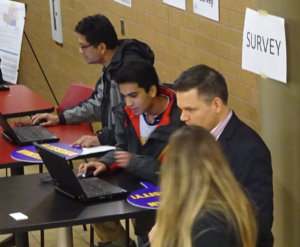 The second survey was released at the first public meeting. It turned out to be less than scientific – anyone from anywhere could do the survey as often as they wished, The data was in the hands of IPSOS Reid at the end of that day. Unfortunately the results are not in the hands of the Board yet – this being early Monday afternoon.
That data will have to at least be looked at by Board staff and then sent along to the 14 PARC members who have just the one evening to go over the data and arrive at their own conclusions.
The 14 PARC members are all volunteers with jobs that keep them busy during the day.
It is both unfair and unprofessional to drop a long data dump on these people at close to the last minute and expect them to make reasonable comments. There is no time for them to talk to their parent groups and get feedback.
 Members of the PARC entering data on large posters. These people have worked long hours and are not being given the respect they are entitled to nor the information they need to form opinions and arrive at conclusions. The PARC was created to act as the official conduit for information shared between the Board of Trustees and school communities. In order for the PARC members to do this they need information on a timely basis – and that just is not happening.
The Ministry of Education Guidelines on the PAR process are new and there are clearly some changes needed.
Consideration might be given to changing the timeline these people have been forced to work within.
The Gazette had hoped to have the survey data in hand and be able to do an analysis so that the public could be aware of that the PARC members are working with.
When a public is shabbily treated by a publicly funded organization they get angry, feel they are being mistreated and look for ways to vent that anger and disappointment. That produces events that are pictured below.
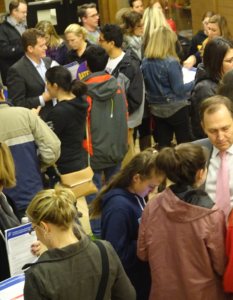 The turn out at the first public meeting where parents could see what the Board of Education wanted to do had hundreds of people show up. The second public meeting has Board staff limiting the number of people who could be in the very large room – they were close to exceeding Fire Marshall limitations.  Unhappy parents who are not given the information they need get angry – resulting in outbursts like this – no one winds and the reputation of the Board gets badly tarnished and the democratic process take a huge hit. Can you imagine what the next election of school board trustees in 2018 is going to look like 
 By Pepper Parr By Pepper Parr
March 20th, 2017
BURLINGTON, ON
With Spring Break over and most of the snow melted away the citizens of the city can begin to look for warm sunny days – and fret about just what is going to happen to the city’s high schools.
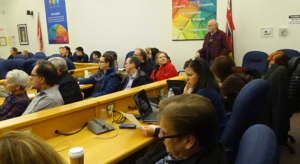 Public attendance was good – not huge but those attending paid very close attention. While many parents were out of the city the Board staff were working towards the last two PARC meetings that will take place later this week; one on Tuesday and a second one on Thursday. The Board would love the PARC to arrive at a consensus – the best this PARC is going to be able to do is go for the option that doesn’t close any of the high schools or choose to close Bateman if it is absolutely necessary to get the number of empty seats down.
This PARC has been less than satisfying to the parents and most of the participants. The process followed is a new one issued by the Ministry of Education (MOE) and it has some, (many?) bumps to be dealt with.
The 14 PARC participants have had a tough time getting a grip on the process and at the same time having to deal with a Board that has not delivered anywhere near enough in the way of data and information.
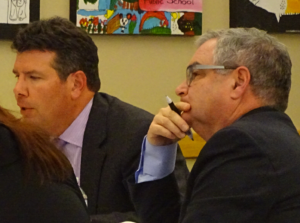 PARC Chair Scott Podrebarac on the left with city manager James Ridge on the right. Ridge had very little to say – the public was never told what his mandate was other than to occupy the seat allocated to the city. The PARC was given nothing in the way of historical background and the reasons why the city now has seven high schools with 1800 + seats that are empty and one high school that is close to 150% of it rated capacity.
They were given a template to use as they made decisions on the various options that were put in front of them. That template asked them to consider, but not be limited to the following:
- Range of mandatory programs;
- Range of optional programs;
- Viability of Program – number of students required to offer and maintain program in an educationally sound and fiscally responsible way;
- Physical and environmental state of existing schools;
- Proximity to other schools (non-bus distances, natural boundaries, walking routes);
- Accommodation of students in permanent school facilities and minimal use of portable classrooms;
- Balance of overall enrolment in each school in the area to maximize student access to programs, resources, and extra-curricular opportunities and avoid over and underutilization of buildings;
- Expansion and placement of new ministry or board programs;
- Stable, long-term boundaries to avoid frequent boundary changes;
- Cost effectiveness of transportation;
- Fiscal responsibilities;
- Existing and potential community uses and facility partnerships;
- Goals and focus of the current multi-year
It would take a single edition of the Gazette to pick apart the 13 points in the framework – transportation is one of the better examples. Every time the question as to the cost of busing and the impact busing would have on the students was brought up everyone from the Director on own was told to “don’t go there” it is far too complex.
The issue that is almost as important as what students learn in the classrooms is how we get them there got shoved to the sidelines because it was too complex.
The Board has deliberately obfuscated on a number of occasions and has kept the PARC away from issues that are critical to finding an acceptable solution that is fiscally prudent, take into consideration the importance of community and strives to give the students the best possible educational advantage. Not an easy thing to achieve but there are some very smart committed people on the PARC. They deserved more respect from the Board than they have been given.
The PARC people had to learn new acronyms that the Board uses daily.
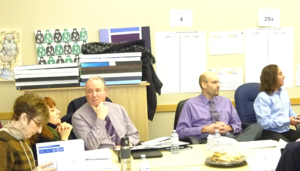 The principals or their proxy were on standby during most of the PARC meetings – they acquitted themselves very well. Not one of them stumbled. The PARC members had to listen to data that was wrong the first time it was given to them and wrong the second time as well.
Parent groups from the high schools most at risk – Central and Pearson to begin with then Bateman and Nelson at a later date.
The public never got the sense that they were really involved. Meetings were held at which the public as not encouraged or given a chance to ask questions.
The five high schools that were not named as possible closure took a pretty relaxed attitude early in the process – when it became evident that Nelson and Bateman were being given a look at for possible closure they got active quickly.
The result was a turf war between the different high schools rather than an open co-operative and collaborative approach to resolving a serious problems.
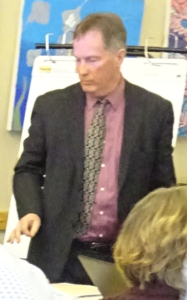 Superintendent of Facilities Gerry Cullen gave a report in which he explained what was wrong with the data they were being given – that was the extent of it – other than to say that was what the Board was working with. During all this the elected trustees chose to be mute. They didn’t want to “influence the process”.
The four Burlington trustees were on hand for every meeting – the others popped in on occasion. The city now faces a situation where all four of its trustees could vote not to close any of the high schools but the other seven trustees (there is a total of 11) could vote to close two of the high schools and that is what would be done.
What the PAR committee has to do is:
Remind themselves that while they were brought together to WHAT that they need to do is look at the bigger picture and determine in their minds what is best overall for the state of the high schools in the city.
 PARC committee members from Ward 1 and 2 talking over what was taking place. Both were very direct with the chair. Each PARC member needs to ask themselves why they are there: To fight for the existence of the school they represent or to be involved in a committee that looks at the available data and if it is insufficient then demand that the Board provide factual data.
The constantly updating data on the part of the Board is unprofessional and unacceptable and the PARC needs to tell the Board as much.
The PARC members need to demand that they have some direct input into the report that goes to the Director of Education. They should also demand that they be given the time and the resources to critique the report the Director gives the trustees March 29th.
Demand that the Board not rush the PARC – these 14 people have full time jobs that require time – as volunteers their time needs to be respected. The PARC should not be made slaves to a time line the board created.
 Somewhere in this crowd are a number of Board of Education Superintendents explaining as best they can what the preferred school closing option is and why it makes sense. Many of the parents weren’t buying it. The PARC has yet to find its voice – hopefully the Spring Break will have given everyone some time to catch their breath and provide the city with the service each one is capable of giving.
There is a lot more riding on this decision than most people realize.

 By Pepper Parr By Pepper Parr
March 19th, 2017
BURLINGTON, ON
Tom Muir’s bottom line is that “the Board is cooking the books”.
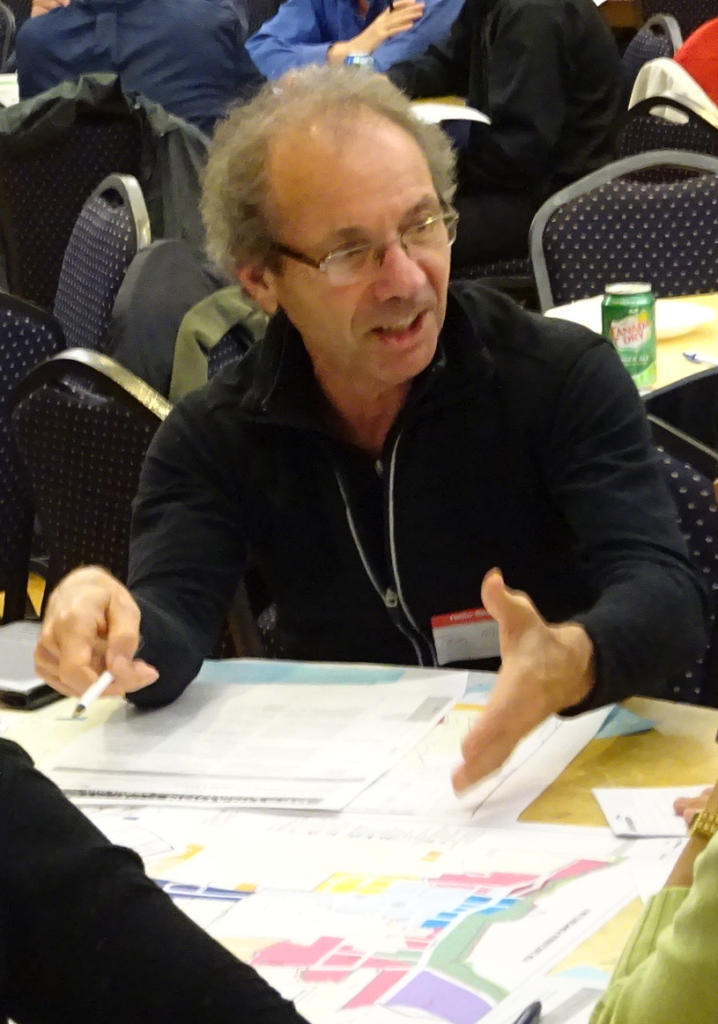 Tom Muir at a downtown planning discussion put on by Ward 2 city Councillor Marianne Meed Ward. Muir, is a Burlington resident who lives in Aldershot. He is a retired federal civil servant and a trenchant observer of what goes on in his city. He was once described as an “acerbic” personality which Muir thought was pretty accurate.
The Board cited two reasons for asking the trustees to hold a Program Accommodation Review:
Condition 1: Low Utilization, Enhance Secondary Programming and Learning Opportunities
Condition 2: Enhance Secondary Programming and Learning Opportunities
The first citing under-utilization of two schools at or below the 65% level is because the Board has cooked the boundaries and feeder distributions to produce that result.
They have done this, says Muir because the 1800 + empty seats in the seven high schools are the result of what the Board did back in 2009 to fill the new high school they convinced themselves was needed for neighbours close to Dundas Street and the homes being built in the newly created Alton Village.
Muir maintains the Board didn’t explain this to “the public or parents”. He adds that the PAR should have held the Bord accountable for that failure because the under-utilization of the existing six schools was part of what the Board knew was going to happen. The Board knew that surplus seats would be produced.” Muir adds “that was known, and part and parcel of the plan, at the time that the Hayden school was being planned.”
They made a deal with the Ministry, claims Muir, to at least partly fund new seats at Hayden by a “future disposition of surplus assets” which would be school properties – which they later identified as Central and Pearson high schools. “This is what they are trying to do now” said Muir.
The overall utilization is 75 to 80%. The new seats in Hayden are at 118 to 150 % – over-utilization of 214 to 604 seats.
 Stuart Miller during a Q&A that was webcast by the school board. According to the Directors Preliminary report, this will only get worse with growth, infill, and other development that is presently assigned to the Hayden boundaries and feeder distribution. These distributions are part of the recipe used to cook the result the Board wants.
In addition, the Board’s population and pupil yield models are projecting enrollment that is too low. The Board knows this but it still using a an enrollment model that produces bad projections. This happened when they did projections in the Alton Village, and this is known, but are still being used.
Muir believes this can be fixed. He suggests a “reshuffle of the city-wide boundaries and feeders can keep all schools above 65%, and move the average utilization toward the 75 to 80% level.
Muir opines that this is not what the Board wants. Not only that, but they are using the cooked books to show only the part of the feasible options that favor what they want, which is closures.
“I would add that the path the Board is on leads to another key logical implication, not yet in people’s consciousness, which is due to the overflowing utilization, portables, and over-directing of new pupils to Hayden” said Muir.
He adds: ” In time, with no boundary and feeder changes to balance things, the stated continued growth there, and actual population and pupil yields that have been over the Board estimates used, there will be another over-utilization based demand for another school. It’s a clear consequence of not changing how the utilization is managed and balanced.
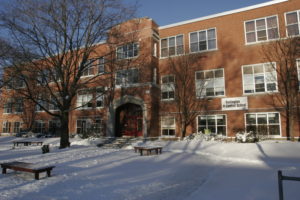 Central high school is the oldest in the city – and needs a lot of repair work. Parents ask why that upgrading work was not done during the past 10 years. Director of Education Stuart Miller responds with: It doesn’t matter where we put the boundaries or how we organize the feeder schools – none of these is going to produce students to fill those 1800 empty seats. And the Ministry of Education is not going to give the Halton District School Board any money to pay for maintaining those seats.
It appears however that funds will be available to do all the work that will come about should the Trustees decide to approve the closing of schools.
There is some hard number crunching to be done to determine just how much it is going to cost to close schools and what is really involved financially long term to keep them open.
Condition 2: Enhance Secondary Programming and Learning Opportunities
The second condition cited in the Directors report to the trustees was that reorganization involving the school or group of schools could enhance program delivery and learning opportunities for students.
“Director Miller repetitively says, and told me personally, that this PAR is only about the students and what is good for them.”
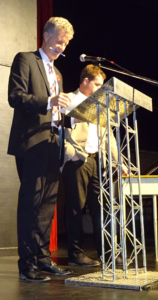 Director of Education Stuart Miller preparing for a public meeting at Central high school. “I have asked Director Miller, the Board, Trustees, and the PARC for a detailed accounting of how much money will be saved, how many new courses will be offered, what will the courses be, how will the courses benefits the students, to how many new students, at what schools, and so on, in a detailed accounting.
“This information has never been provided and doesn’t seem to be in the offing.
Muir wants to know how if no such information is provided can the PAR condition be met.
“Also, maybe people don’t know, but the Board doesn’t have to spend the savings from closures, or other measures, on providing these additional classes and opportunities.”
Before we make such decisions based on assumptions, the PARC and Trustees should be asking for the information I asked for, and for Board and Director assurances that this will be delivered.
Muir maintains “this cooking of data and misinformation by the Board was started and done to get Hayden opened. They are doing it in order to smokescreen the options toward the closures they want and that were agreed to with the Ministry in 2009.
This means that all feasible options, of which there are many, are not being explored and explained.
All management and cost-benefit data and information is not being provided.
Muir argues that “the Board has no credibility and cannot be trusted. He told the PARC and the Trustees at the start of this PAR process, “that this is what the Board staff will do to them, and that if they tolerate it, they will be led down the garden path, which is what is happening. The Director is not their friend. The Board are not their allies.”
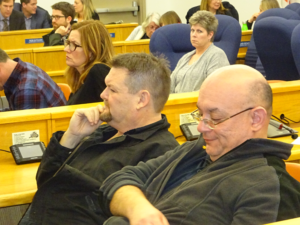 Parents listening to the proceedings of the PARC Muir believes that the only thing that will save all their schools is solidarity. “You have to pull together. You have to demand the information you want and need to meet the PAR conditions and as many criteria as you set to meet yourself.
At bottom, the only power, and this is the real trump card of the Trustees, is that they have the power of the law.
No matter what anyone says or does, Board or Director, Ministry, the Trustees decide with their votes what will actually done.
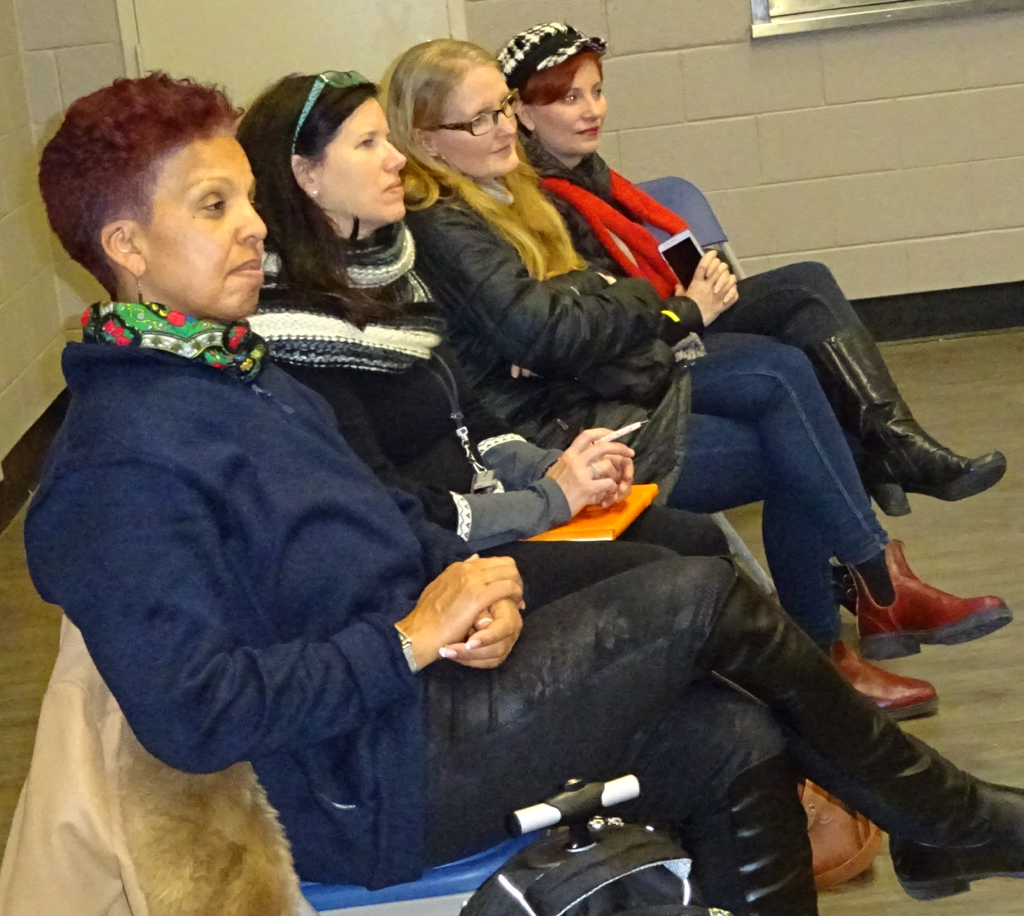 Four of the eleven Halton District school board trustees listening to the presentation given by Board Staff early in December. The Trustees are the law.
Muir pleads that PARC members not “waste this power fighting among each other, because you are all at risk, either now or in the not too distant future.”
Muir believes all the misleading misinformation, and the way the system talks in code, and partial truth is at the root of the problem the community faces. “Remember” advises Muir,” every partial truth is the beginning of a new lie.”
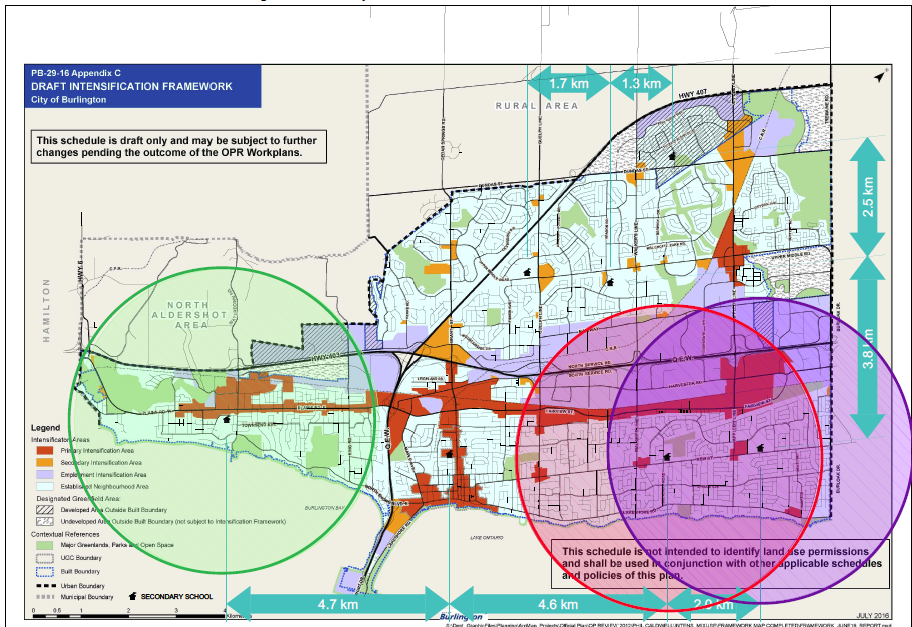 Catchment boundaries are complex – the PAR committee was faced with 30 options to deal with. The prime concern for many was the lack of a high school that would serve the families in the downtown core. Aldershot on the left appears to have the balance needed – in the east end of the city Nelson and Bateman have catchments that overlap – which raised the question: Should either Bateman or Nelson be closed? Tom Muir is not the easiest man to get along with. He is direct, being polite is not his objective. Facts looked at logically will produce results that can be lived with is where he comes from.
Several months ago when Muir was delegating at city council, when Council wanted to reduce delegation time from 10 minutes to five he said:
“I would hope that Council votes in favor of the 10 minutes unanimously, as a show of good faith. I will say that a vote to reduce to 5 minutes is something I see as an insult to citizens and their possible contribution to what we do as a city – our city.”
“Further, if Councillors still want to vote down the 10 minutes, I say this. If you are so tired of and frustrated by, listening to the views of the people that elected you, then maybe you have been doing this job too long and should quit. I mean that, and will not forget how this vote goes tonight. “
“This Council is not your Council; it is the people’s Council.
“And these Council Chambers are not your Chambers, but are equally, the people’s Chambers. All the Councillors and Councils hold these offices and chambers in trust. A vote to reduce the people’s time to speak in these chambers is to fail in that trust.”
City council kept delegations at the 10 minute level.
The Halton District School Board exists to serve the needs and desires of the public not the wishes of the Director of Education and senior staff.
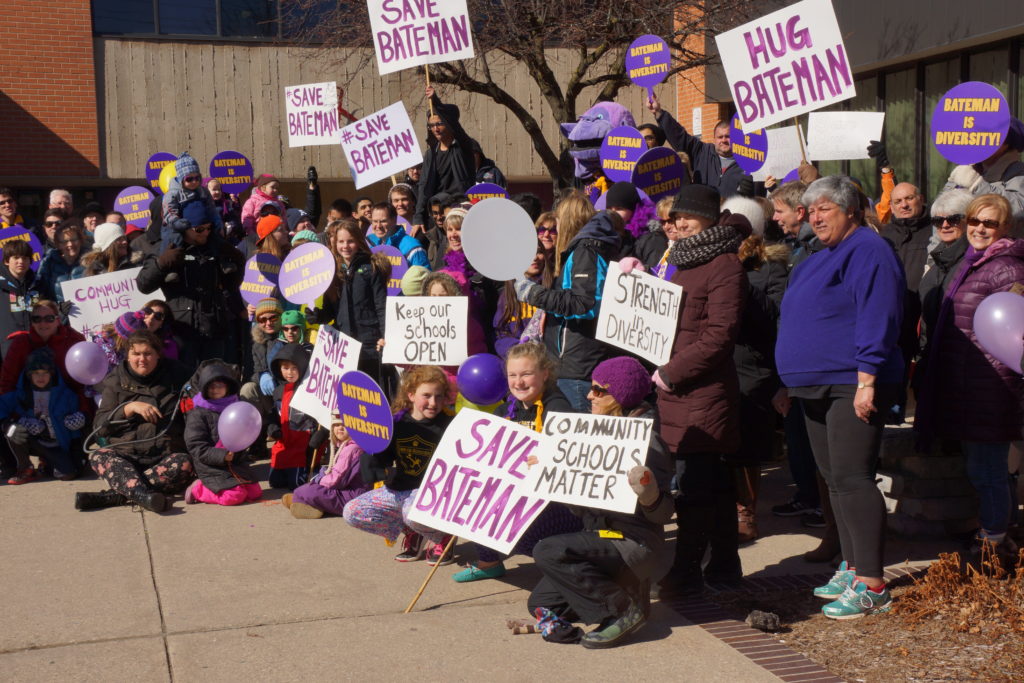 Muir thinks quiet, polite demonstrations (the Burlington model) are not the answer. Demanding accurate data on a timely basis so that people can make informed decisions is the only way parents are going to be heard is Muir’s advice. When the closure of high schools in the city became a public issue Muir had some advice for the parents that were going to be impacted.
“If parents don’t let their outrage loose, and in mass numbers demand answers to their key questions, on a schedule parents set, to the Board, and the Trustees, and your Councillor and Mayor, and right now, immediately, then the trip down the garden path will continue.
“Parents have to self-organize and go to war for what they want. Sheep are for slaughter. They are the big bad wolf.
“If parents don’t do this, then give up, because they will just put you down slowly, on their schedule, with their information driving the bus your kids are on.
“Don’t kid yourself, and don’t go quietly.”

 By Pepper Parr By Pepper Parr
March 17, 2017
BURLINGTON, ON
Run that by me again – Why are we doing this ?
According to the Board’s Program and Accommodation Review (PAR) policy, a Program and Accommodation Review is initiated if one of the five conditions listed in the policy are met. Out of the five conditions, two have been met which justifies the PAR.
 Director of Education Stuart Miller. There are five conditions but no one at the Ministry of Education wants to say what the five are. Director of Education Stuart Miller uses two of the five to justify his report to the trustees asking that a PAR be held on the Burlington high schools.
The HDSB web site has details on how the two conditions the Director refers to were met – they are set out below.
What the Gazette cannot find out is – what are the other three conditions. Director Miller used two of the five. What the other three are is not known to us. A call to the Ministry of Education got nothing but a statement on how much money they are spending in Halton. It was an almost pure piece of public relations fluff.
Condition 1: Low Utilization, Enhance Secondary Programming and Learning Opportunities
Condition 2: Enhance Secondary Programming and Learning Opportunities
Condition 1 states that the school or a group of schools has/have experienced or will experience declining enrolment where On-The-Ground Capacity (OTG) utilization rate is below 65%. Currently two secondary schools in Burlington have utilization rates below 65%, and one school is approaching this threshold. It is projected that all three schools will be below 65% utilization by 2020:
School OTG (Building Capacity) 2015 Enrolment, 2015 Utilization, 2020 Enrolment, 2020 Utilization

Condition 2: Enhance Secondary Programming and Learning Opportunities
By reorganizing the school and creating larger grade sizes and enrolments, the Halton District School Board can enhance program delivery by offering more courses and a variety of courses using funding that would otherwise be spent on maintaining empty spaces. The benefits of each school type are highlighted in the table below.
School Type/Benefits
Small Secondary School (Enrolment of 600 or less)
Staff tend to know each student better and may be more able to proactively intervene to support a student who is in need of assistance;
Extra-Curricular Participation – while the number and types of activities available to students may be fewer in a smaller school, students are more likely to make a team/activity because there are fewer students interested in participating in each team/activity;
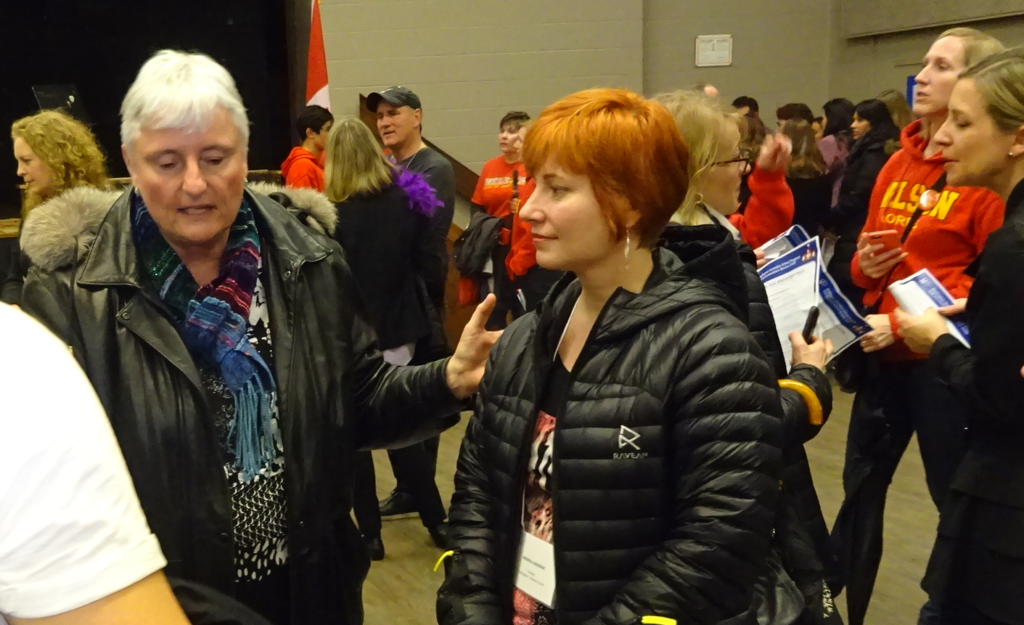 Trustees Grebenc and Grey – are they listening t the students – and the parents? Higher ratio of service area staff to students – to maintain core functions in the area of Special Education, Guidance and Library, smaller schools have a significantly richer staffing ratio than larger schools. This however comes with increased costs to the Board;
Less pressure on the physical space in the building e.g. less scheduling challenges on gym space.
Large Secondary School (Enrolment of 1000 or more)
More course options available to students to support different learners, interests and pathways.
Fewer scheduling and timetable conflicts – In the 2014/2015 school year, 39% of students at smaller schools had timetable conflicts while at larger schools 19% of students had timetable conflicts. Timetable conflicts often result in students not being able to take a course they had selected because two or more of their selected courses are running in only one semester at the same time.
Fewer “shared” students – a shared student is a student that is registered in more than one school. These students register for a course they require/want that is not available in their home school. In 2014/2015 12% of students (234 students) were considered a shared student in small homes schools. 4% of students in a large home school were considered shared students (169 students).
Fewer Early Leavers in larger schools – An Early Leaver is a student that leaves school prior to graduating. In 2014/2015 the percentage of early leavers prior to graduation was 1% at large schools and 3% at smaller schools. This in turn affects the graduation rates at high schools.
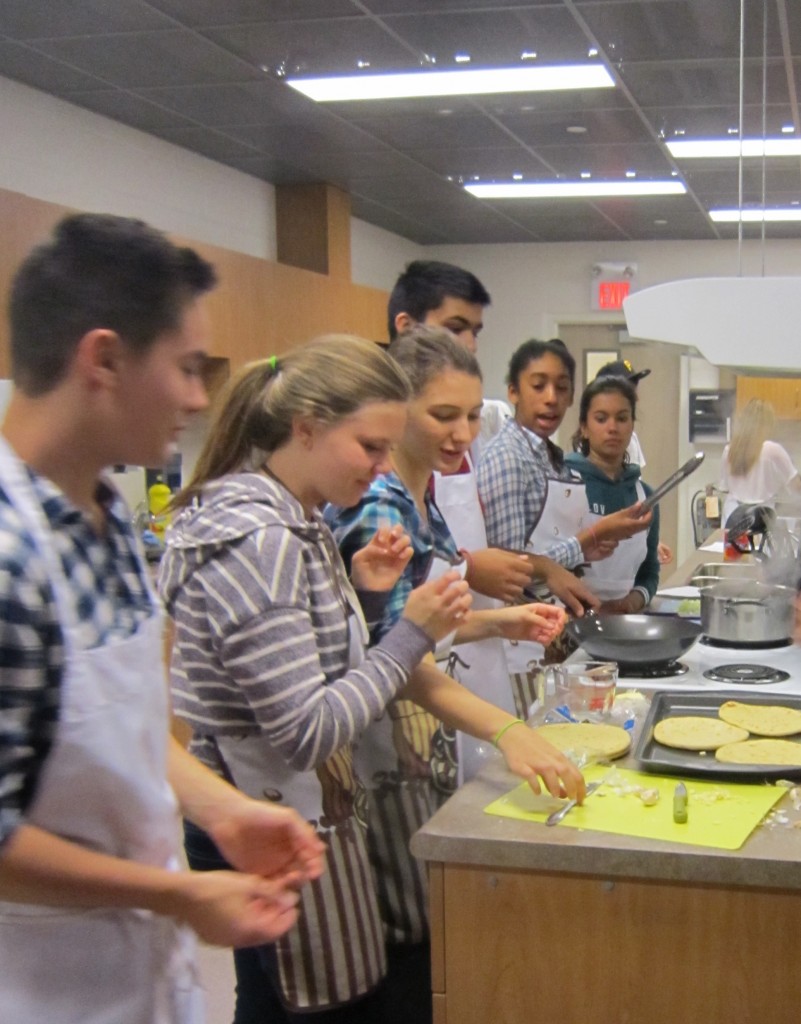 Bateman students in the cooking class. More teacher subject specialization – more classes mean more teachers, therefore it is more likely to get specialized teachers while smaller schools with limited classes have less diversity in staff. For instance in larger schools there may be 4-5 science teachers, a biology specialist, physics specialist , a chemistry specialist and two science generalist, while at a small school there may be only 2 science teachers to teach all science curriculum areas.
More opportunities for Extra-Curricular participation – in larger schools there are more staff and thus more opportunity for greater special interests and skills and thus a greater offering of extracurricular activities.
More funding for students, less spent on maintaining empty spaces.
That’s two of the five conditions. We want know what the other three conditions are.

 By Pepper Parr By Pepper Parr
March 16th, 2017
BURLINGTON, ON
There is something wrong with the schedule.
The 14 members of the PARC are going to meet on March 21st and again on the 23rd.
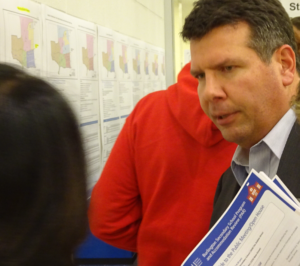 Superintendent Scott Podrebarac, Chair of the PARC, will write the report on what he determines the PARC members arrived at in the way of conclusions and any recommendations they might make. Then the Chair of the PARC, Scott Podrebarac is going to write a report on whatever conclusions he thinks the PARC arrived at and turn it over to Stuart Miller, Director of Education who will in turn craft his report to the trustees which they will receive on March 29th.
The Director will have less than six days to write his report, review it with staff and do a couple of re-writes.
Where is the time to reflect on the months of deliberations the 14 PARC members put in.
Will individual PARC members be putting together their comments and sending them along to the Director of Education?
 PARC members will have deliberated for more than six sessions, some of which went for more than three hours – they exchanged hundreds, probably more than 1000 emails and debated vigorously. Might the PARC itself file a minority report to give some balance to what Scott Podrebarac, Chair of the PARC produces?
There are many who think the work that PARC was asked to do is a farce.
At some point the people paying for the operation of a school board, that’s you the taxpayer, have to stand up on their hind legs and declare that enough is enough.
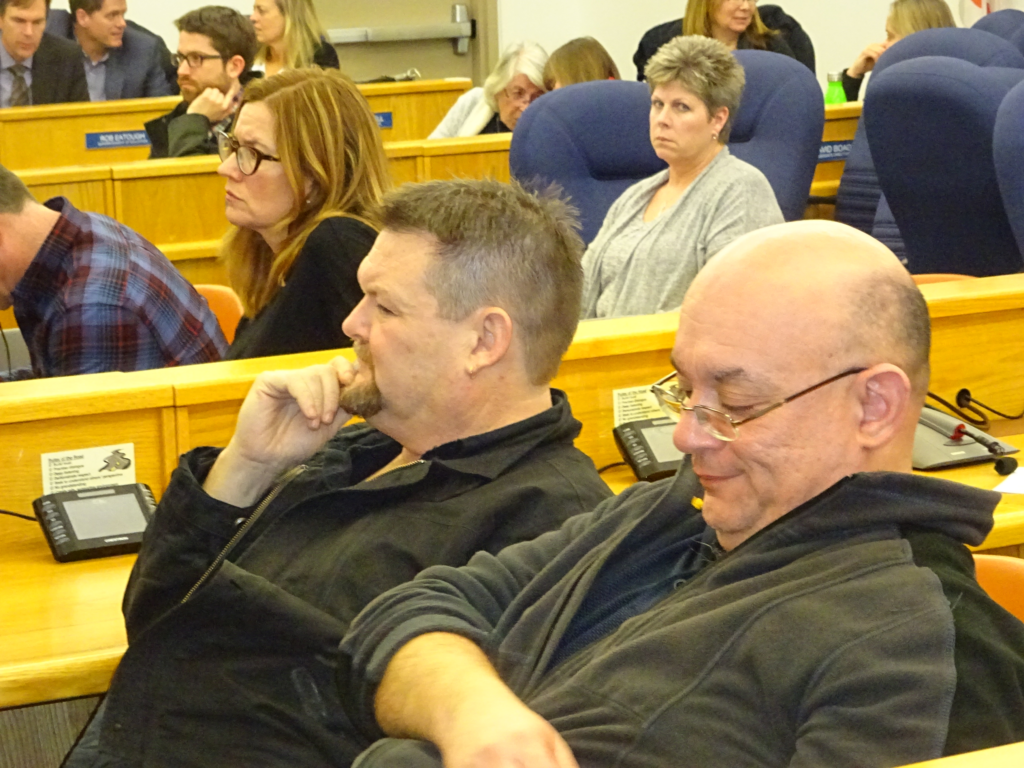 Parents listen intently at what the PARC members have to say. Many feel the completing of the PARC report allows the Director of Education to tick off a box on his to do list and move on to the next task which is to shut down two high schools.
There was a point at which the Halton District Catholic School Board (HDCSB) was in serious talks with the public school board for a possible purchase of Pearson high school. The Gazette has been told that Fred Thibeault, one of the HDCSB planners, exhausted all possibilities with coterminous, (that would be HDSB) French Catholic, French Public and the City and wasn’t able to work something out – they didn’t really go anywhere was the comment the Gazette got from a former chair of the HDCSB
The Catholic school board held a Program Accommodation Review for the elementary Burlington panel of schools. The Board staff had St. Paul slated to close; the vote to do that was lost – so it can be done.

 By Pepper Parr By Pepper Parr
March 14th, 2017
BURLINGTON, ON
Just how does Crime stoppers work?
Everyone knows what Crime Stoppers is. Few know just how it works other that there are cash awards for some tips.
The Gazette publishes the following at the bottom of every crime related news article. The Regional Police add it to everything thy send out.
Tips can also be submitted anonymously to Crime Stoppers “See something, Hear something, Say something” at 1-800-222-8477 (TIPS), through the web at www.haltoncrimestoppers.ca, or by texting “Tip201” with your message to 274637 (crimes).
How effective is the service? Stats for 2016:
Number of Crime Stoppers tips called in – 1,218
Arrests made as the result of a Crime Stoppers tip: 36
Cases Cleared as the result of a Crime Stoppers tip: 25
Charges Laid as the result of a Crime stoppers tip: 75
Property Recovered as the result of Crime Stoppers tips: $40,630
Drugs Seized due to Crime Stoppers tips: $87,600
So – how does being anonymous actually work?

When someone calls the 1-800 number they are asked not to personally identify themselves. The Crime stoppers telephone number does not have call display on any of its lines.
Cal Millar, the Crime Stoppers vice chair explains that most people don’t call Crime Stoppers looking for a financial reward – they want to help but they don’t want to be identified.
When a person calls Crime Stoppers they are given a six digit file number – and that is the way they know each other – by a number. “If a person tells us who they are, our trained Crime Stoppers operator immediately ends the call and instructs the caller to call the police.
The anonymity is core to what Crime Stoppers does; people, for the most part do not call for the reward money.
When there is a cash payout – how does a caller get the money – that’s a part of Crime Stoppers that results in a lot of humourous stories.
 What Crime Stoppers vice chair Cal Millar might have looked like when he was handing over a reward – there would have been a flower in the lapel of the trench coat. Millar recalls the time he was to meet a Crime Stoppers caller. “I had an envelope with cash in it and had agreed to meet the caller at an agreed upon location. Because names were not being used I said I would be wearing a flower in the lapel of my jacket and would be standing near a stairway in a public place.”
“The Crime Stopper approached me” said Millar, “ told me what the six digit identifying number was and it matched what I had on the envelop so I passed it over and we each went our separate ways.”
The cloak and dagger days are in the past for Crime Stoppers. The organization has a number of trusted partners who hold the envelopes for people to pick up. A recipient of a cash award will drop by an office or a retail location and ask if there is an envelope. Give the clerk the identifying number and the envelope gets handed over.
 A tribute to the Eagles – Hotel California at the St Volodymyr Cultural Centre on March 30th. Where does the reward money come from? That’s what Crime Stoppers fund raising is all about. They hold events and raise funds that they then hand out.
Crime Stoppers has an event coming up on March 30th. Hotel California will be playing at St Volodymyr Cultural Centre on March 30th.
Crime Stoppers is supported by the Regional Police who provide office space and a trained staffer who has security clearance to handle the incoming calls.
There is also a police officer assigned to the unit as liaison. The role is currently filled by Detective Constable Jodi Thompson.
Police throughout Canada and the United states will tell you that after fingerprints Crime Stoppers is the best investigative tool they have. DNA has since been added to the best tools the police have.

 By Pepper Parr By Pepper Parr
March 14th, 2017
BURLINGTON, ON
Halton District School Board Director of Education Stuart Miller is not wrong – but he isn’t right enough either.
Miller is an educator. He is not a sociologist, he is not a politician. He is a lifelong teacher who grew into an education administrator.
Mention a student he taught 15 years ago at a school in Oakville and he will tell you things about that student they may have forgotten. He is passionate about the work he does.
 Stuart Miller works from his smile – open and very much the professional educator who wants nothing but the best for his students. Whenever there is an event that will have more than 25 students on a Saturday morning and he will show up – coffee cup in hand.
He slips out of his office at noon frequently to drive over to Bateman and have the lunch that comes out of the excellent kitchens the students run. Then he sits and eats his meal with the students.
He is exceptionally open: not everyone will agree with that statement but he is a lot more open to media than any one of the politicians in the Region. Many parents don’t feel he listens well enough; just because he doesn’t agree with them – that doesn’t mean he is not listening,
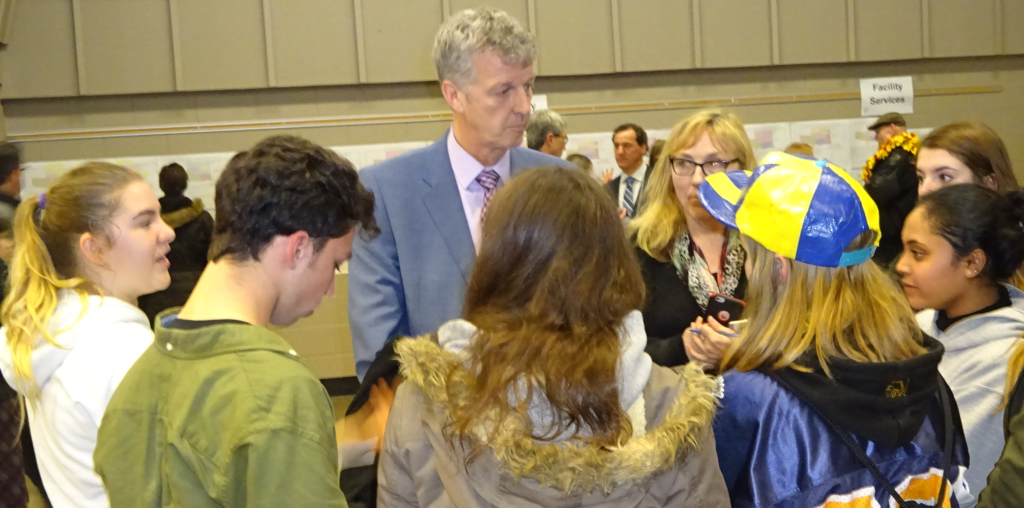 Miller is fully aware of the world his students are going into – and he wants as prepared as he can make them. He listens to the parents that want to keep their local high school open and he is mindful of their concerns but for Miller his job is to give the students he is responsible for the best education possible and that means offering every course he can in every school.
In order to do that Miller believes he needs larger high schools with more teachers to give more versions of the same course so students don’t lose out due to class conflicts. Those are the well-developed views of a professional administrator.
Parents appear to be Ok with their children going to a different school for some of their courses and Miller does what he can to make that possible.
He believes that a big high school with a lot of staff is the route to go – so when he says he wants what is best for the students he is talking about the course offerings.
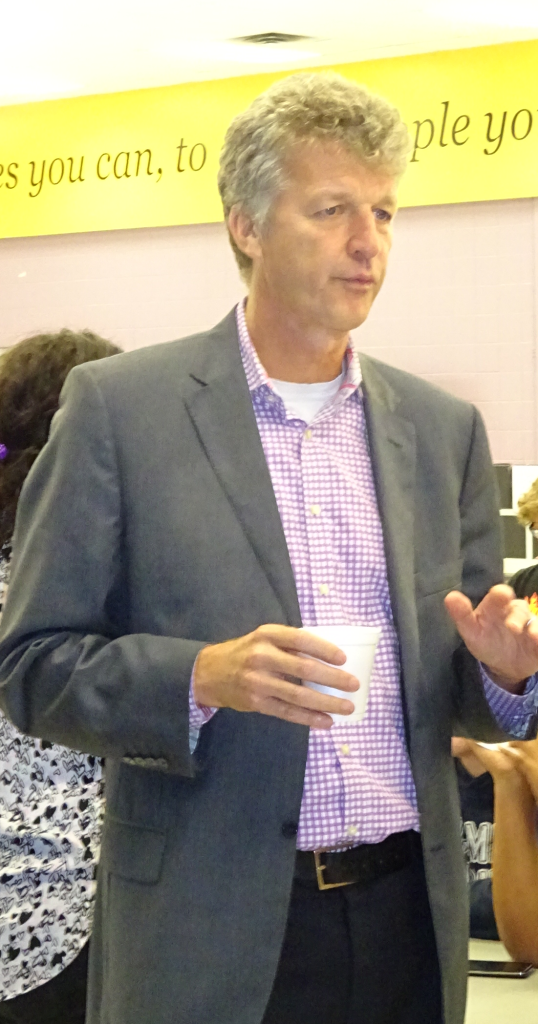 Miller with the ever present coffee cup. That a school has some history the students can attach themselves to is something Miller grasps but he doesn’t understand why a person would put a first class education before having a school they can walk to.
Miller doesn’t live in Burlington. He commutes to Burlington from High Park and uses the 45 minute drive to think through the day he is getting into.
Miller is all about education – he could have a stronger team supporting him but he hasn’t been the Director of Education for two years yet – the public might yet see him as the person who creates a team of Superintendents for the Halton District School Board that are second to none. He doesn’t have that yet.
The team he has is made up of decent people but they have not given Miller anything in the way of new ideas or innovative approaches to solving the problem he faces.
The lens Miller looks through is those 1800 + empty classroom seats and from his perspective it doesn’t matter how he re-arranges the boundaries or the feeder elementary schools – he still has those 1800 empty seats.
What Miller and his staff have not done is come up with proposals or initiatives for the trustees to consider. The province doesn’t fund empty seats.
While Miller has said again and again that the issue is not about money, from his perspective but it is in reality a money issue.
If the trustees decide to not close any of the high schools and to shift boundaries so that the pressure is taken off Hayden and Pearson gets back the population it once there will be more balance – but the city will still have high schools with considerably less than the 1000 students Miller thinks are needed to be able to offer a full palette of course offerings.
 The Halton District School Board in session. Eight of the 11 trustees have just a little over two years experience. A number of them may not have the depth of experience to handle the task ahead of them. A couple have been on the Board far too long. The trustees need to instruct Miller to give them financial options. If every high school is to be kept open the money to pay for those empty seats has to be found somewhere. The trustees need to direct the Director to find the savings within the budget they now work with.
The philosophy board staff appear to work from is bigger schools mean better educations at the high school level.
It is the trustees, serving the people who voted for them that make the final decision – and if the parents want all the school kept open so that a sense of community is kept with the schools we have and they want students walking rather than spending a significant part of each day on a bus – then that is what the trustees should be expected to deliver.
Miller is open to new ideas – he welcomes them and he listens intently – but he doesn’t appear to be a new idea kind of guy.
He spent some time in Africa with his wife but other than that his career has been with Halton where he started out as a teacher and grew into a bureaucrat who now faces the biggest administrative challenge of his career.
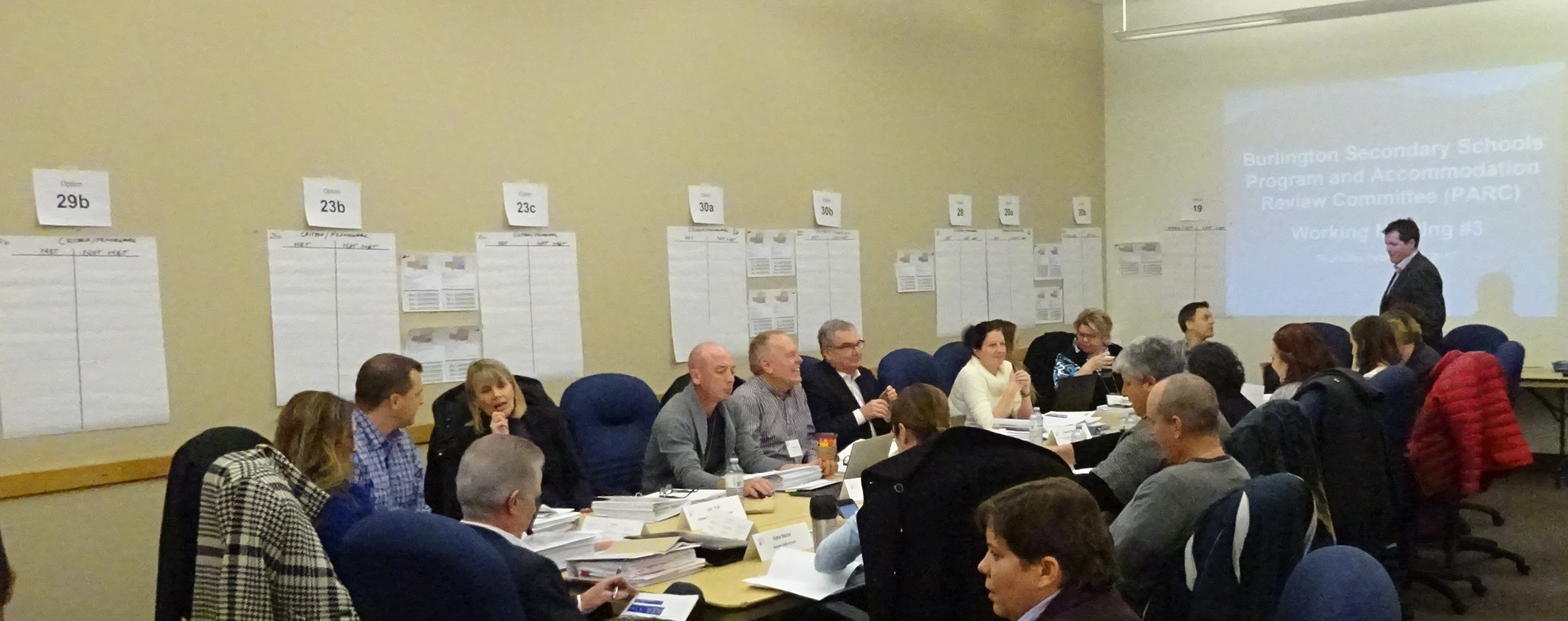 Why is this PARC not leading more instead of following a process that the smarter members believe to be seriously flawed? The Program Accommodation Review Committee (PARC) is not coming up with much in the way of new ideas – they have become a group that is squabbling with the different high school representatives fighting for their own turf.
Board staff are leading the PARC through a process and the members of the PAR are putting up with it. There are voices on the PARC that can and should be showing much more in the way of leadership.
Miller will serve as the Director for perhaps another ten years. He doesn’t appear to be the kind of guy that will go up against the Ministry of Education. He doesn’t appear to have any aspirations to become part of the provincial government bureaucracy either.
A strong board of trustees can develop their Director of Education into the kind of person the city needs. The Director can then develop the staff that he needs.
Stuart Miller is a passionate advocate focused on giving the students in Halton the best education possible.ll about the students.
What he needs to appreciate is that those students have parents who also have a say, the say for that matter – at least in a democracy.
He is not wrong, but he is not right enough on the community element which is a large part of an education.
 Salt with Pepper is an opinion piece by the publisher of the Gazette who has been covering Boards of Education since the Living and Learning document was released when Bill Davis was the Minister of Education. Salt with Pepper is an opinion piece by the publisher of the Gazette who has been covering Boards of Education since the Living and Learning document was released when Bill Davis was the Minister of Education.

 By Staff By Staff
March 13, 2017
BURLINGTON, ON
Tomorrow, (Tuesday, March 14, 2017) the Halton District School Board office and all Board-related sites will be closed due to significantly poor weather conditions that are forecast to track into the region over the next several hours.
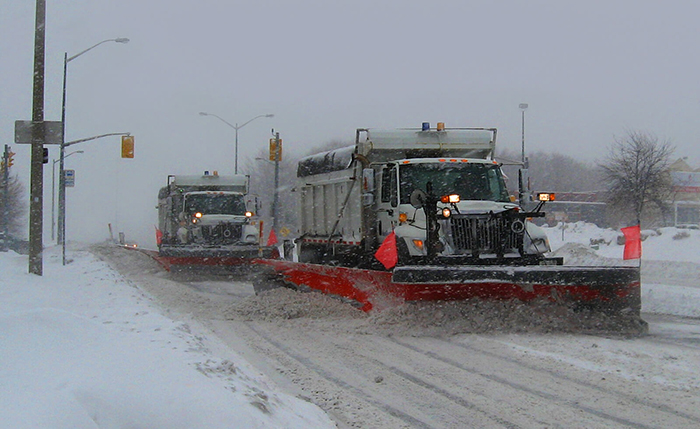 Trucks will be out in force. The city has its plows on the road – snow continues to fall. Significant snowfall is predicted.

 By Staff By Staff
March 13th, 2017
BURLINGTON, ON
It’s Fraud Prevention Month (#FPM2017) and the Halton Regional Police Service released the second of four scheduled Frauds of the Week: Emergency Scams. Emergency scams typically target older individuals and play upon their emotions to steal their money.
 According to the Better Business Bureau of Canada, the total amount lost to emergency scams in 2016 was $1.9 million. Since January 1, 2017, eight to ten victims in Halton alone have been defrauded of funds. One of these victims lost $14,000. Like romance scams, actual figures are believed to be much higher as victims often feel too ashamed to report fraud to police. According to the Better Business Bureau of Canada, the total amount lost to emergency scams in 2016 was $1.9 million. Since January 1, 2017, eight to ten victims in Halton alone have been defrauded of funds. One of these victims lost $14,000. Like romance scams, actual figures are believed to be much higher as victims often feel too ashamed to report fraud to police.
“Emergency scams work well because fraudsters throw victims into a state of mini-crisis,” according to Staff Sergeant Chris Lawson of the Regional Fraud Unit. “When this happens, the ability to think clearly or assess a situation is hampered and the first inclination – to help – kicks in.”
In a typical emergency scam scenario, an older person receives a phone call from someone claiming to be their grandchild, neighbour or friend of the family. The caller goes on to say that they are in some kind of trouble, a car accident, stranded in a foreign country or in jail, and need money immediately.
Some victims may get calls from two people, one purporting to be their loved one and the other a police officer or a lawyer. The caller will ask potential victims a series of leading questions which prompts them to volunteer personal information. Callers say that they don’t want others to find out what has happened. Typically, they will ask for money to be wired through a money transfer company.
More recently, victims have been asked for gift cards, known as “steam cards” as payment instead of money. In this variation, victims are asked to purchase the cards and read their serial codes to the caller over the phone.
Victims often don’t verify the caller’s story until after the money has been sent or the gift card information shared and cashed in.
The following tips to protect yourself from emergency scams have been provided courtesy of the Better Business Bureau and Royal Canadian Mounted Police:
• Remember: Scammers count on the fact that victims will want to act quickly to help their loved one in an emergency.
• Caution: Never send money to anyone you don’t know and trust. Verify the person’s identity before you take any steps to help.
• Think: Don’t give out any personal information to the caller.
• Investigate: Ask the person questions that only your loved one would be able to answer. Call someone you both know to verify the story. Scammers can learn a lot about you from social media, or while talking to you on the phone.
• Ask yourself: Does the caller’s story make sense?
• Important: Police will never ask you for money, steam cards or other forms of payment.
Anyone with information pertaining to a fraud or any other crime is asked to contact the Regional Fraud Bureau Intake Office at 905-465-8741 or Fraud@haltonpolice.ca. Tips can also be submitted anonymously to Crime Stoppers “See something, Hear something, Say something” at 1-800-222-8477 (TIPS), through the web at www.haltoncrimestoppers.ca, or by texting “Tip201” with your message to 274637 (crimes).

|
|
 Those Program Accommodation Review Committee (PARC) members were expected to work with the parent groups and take the parent views back to the PARC.
Those Program Accommodation Review Committee (PARC) members were expected to work with the parent groups and take the parent views back to the PARC.

























































































